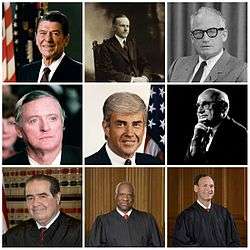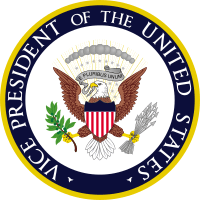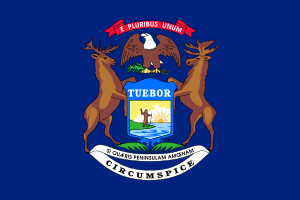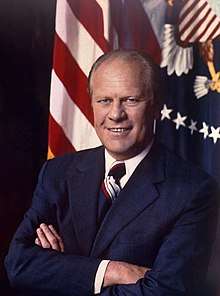Gerald Ford
| Gerald Ford | |
|---|---|
.jpg) | |
| 38th President of the United States | |
|
In office August 9, 1974 – January 20, 1977 | |
| Vice President |
None (Aug–Dec. 1974) Nelson Rockefeller (1974–1977) |
| Preceded by | Richard Nixon |
| Succeeded by | Jimmy Carter |
| 40th Vice President of the United States | |
|
In office December 6, 1973 – August 9, 1974 | |
| President | Richard Nixon |
| Preceded by | Spiro Agnew |
| Succeeded by | Nelson Rockefeller |
| House Minority Leader | |
|
In office January 3, 1965 – December 6, 1973 | |
| Deputy | Leslie C. Arends |
| Preceded by | Charles A. Halleck |
| Succeeded by | John Jacob Rhodes |
| Chair of the House Republican Conference | |
|
In office January 3, 1963 – January 3, 1965 | |
| Leader | Charles A. Halleck |
| Preceded by | Charles B. Hoeven |
| Succeeded by | Melvin Laird |
| Member of the U.S. House of Representatives from Michigan's 5th district | |
|
In office January 3, 1949 – December 6, 1973 | |
| Preceded by | Bartel J. Jonkman |
| Succeeded by | Richard Vander Veen |
| Personal details | |
| Born |
Leslie Lynch King Jr. July 14, 1913 Omaha, Nebraska, U.S. |
| Died |
December 26, 2006 (aged 93) Rancho Mirage, California, U.S. |
| Resting place | Gerald R. Ford Presidential Museum, Grand Rapids, Michigan, U.S. |
| Political party | Republican |
| Spouse(s) | |
| Children | |
| Parents | |
| Education |
University of Michigan (BA) Yale Law School (JD) |
| Signature |
|
| Military service | |
| Allegiance |
|
| Service/branch |
|
| Years of service | 1942–1946 |
| Rank |
|
| Battles/wars | World War II |
| Awards |
|
Gerald Rudolph Ford Jr. (born Leslie Lynch King Jr; July 14, 1913 – December 26, 2006) was an American politician who served as the 38th President of the United States from August 1974 to January 1977. Before his accession to the presidency, he served as the 40th Vice President of the United States from December 1973 to August 1974. Ford is the only person to have served as both vice president and president without being elected to either office.
Ford was born in Omaha, Nebraska, and attended the University of Michigan and Yale Law School. After the attack on Pearl Harbor, he enlisted in the U.S. Naval Reserve, serving from 1942 to 1946; he left as a lieutenant commander. Ford began his political career in 1949 as the U.S. Representative from Michigan's 5th congressional district. He served in this capacity for 25 years, the final nine of them as the House Minority Leader. Following the resignation of Spiro Agnew, he was the first person appointed to the vice presidency under the terms of the 25th Amendment. After the resignation of Richard Nixon, Ford automatically assumed the presidency. His 895 day-long presidency is the shortest in U.S. history for any president who did not die in office.
As president, Ford signed the Helsinki Accords, which marked a move toward détente in the Cold War. With the collapse of South Vietnam nine months into his presidency, U.S. involvement in Vietnam essentially ended. Domestically, Ford presided over the worst economy in the four decades since the Great Depression, with growing inflation and a recession during his tenure.[1] In one of his most controversial acts, he granted a presidential pardon to President Richard Nixon for his role in the Watergate scandal. During Ford's presidency, foreign policy was characterized in procedural terms by the increased role Congress began to play, and by the corresponding curb on the powers of the President.[2] In the Republican presidential primary campaign of 1976, Ford defeated former California Governor Ronald Reagan for the Republican nomination. He narrowly lost the presidential election to the Democratic challenger, former Georgia Governor Jimmy Carter.
Following his years as president, Ford remained active in the Republican Party. His moderate views on various social issues increasingly put him at odds with conservative members of the party in the 1990s and early 2000s. After experiencing a series of health problems, he died at home on December 26, 2006. At the time of his death he was the longest-lived president in American history, a record he held until George H. W. Bush surpassed him on November 25, 2017.
Early life
Ford was born Leslie Lynch King Jr. on July 14, 1913, at 3202 Woolworth Avenue in Omaha, Nebraska, where his parents lived with his paternal grandparents. He was the child of Dorothy Ayer Gardner and Leslie Lynch King Sr., a wool trader. His father was a son of prominent banker Charles Henry King and Martha Alicia King (née Porter). Gardner separated from King just sixteen days after her son's birth. She took her son with her to Oak Park, Illinois, home of her sister Tannisse and brother-in-law, Clarence Haskins James. From there, she moved to the home of her parents, Levi Addison Gardner and Adele Augusta Ayer, in Grand Rapids, Michigan. Gardner and King divorced in December 1913, and she gained full custody of her son. Ford's paternal grandfather Charles Henry King paid child support until shortly before his death in 1930.[3]
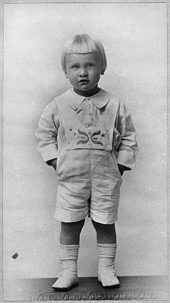
Ford later said that his biological father had a history of hitting his mother.[4] In a biography of Ford, James M. Cannon—a member of the Ford administration—wrote that the separation and divorce of Ford's parents were sparked when, a few days after Ford's birth, Leslie King took a butcher knife and threatened to kill his wife, his infant son, and Ford's nursemaid. Ford later told confidantes that his father had first hit his mother when she smiled at another man during their honeymoon.[5]
After living with her parents for two-and-a-half years, Gardner married Gerald Rudolff Ford on February 1, 1916. Gerald was a salesman in a family-owned paint and varnish company. They now called her son Gerald Rudolff Ford Jr. The future president was never formally adopted and did not legally change his name until December 3, 1935; he also used a more conventional spelling of his middle name.[6] He was raised in Grand Rapids with his three half-brothers from his mother's second marriage: Thomas Gardner "Tom" Ford (1918–1995), Richard Addison "Dick" Ford (1924–2015), and James Francis "Jim" Ford (1927–2001).[7]
Ford also had three half-siblings from the second marriage of Leslie King Sr., his biological father: Marjorie King (1921–1993), Leslie Henry King (1923–1976), and Patricia Jane King (1925–1980). They never saw one another as children and he did not know them at all. Ford was not aware of his biological father until he was 17, when his parents told him about the circumstances of his birth. That year his biological father, whom Ford described as a "carefree, well-to-do man who didn't really give a damn about the hopes and dreams of his firstborn son", approached Ford while he was waiting tables in a Grand Rapids restaurant. The two "maintained a sporadic contact" until Leslie King Sr.'s death in 1941.[4][8]
Ford said, "My stepfather was a magnificent person and my mother equally wonderful. So I couldn't have written a better prescription for a superb family upbringing."[9]
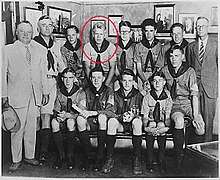
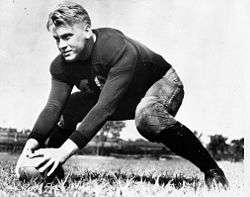
Ford was involved in the Boy Scouts of America, and earned that program's highest rank, Eagle Scout.[10] He is the only Eagle Scout to have ascended to the U.S. Presidency.[10]
Ford attended Grand Rapids South High School, where he was a star athlete and captain of the football team.[11] In 1930, he was selected to the All-City team of the Grand Rapids City League. He also attracted the attention of college recruiters.[9]
College and law school
Ford attended the University of Michigan and joined the Delta Kappa Epsilon fraternity (Omicron chapter). He washed dishes at his fraternity house to earn money for college expenses.
Ford played center, linebacker, and long snapper for the school's football team[12] and helped the Wolverines to two undefeated seasons and national titles in 1932 and 1933. In his senior year of 1934, the team suffered a steep decline and won only one game, but Ford was still the team's star player. In one of those games, Michigan held heavily favored Minnesota—the eventual national champion—to a scoreless tie in the first half. After the game, assistant coach Bennie Oosterbaan said, "When I walked into the dressing room at halftime, I had tears in my eyes I was so proud of them. Ford and [Cedric] Sweet played their hearts out. They were everywhere on defense." Ford later recalled, "During 25 years in the rough-and-tumble world of politics, I often thought of the experiences before, during, and after that game in 1934. Remembering them has helped me many times to face a tough situation, take action, and make every effort possible despite adverse odds." His teammates later voted Ford their most valuable player, with one assistant coach noting, "They felt Jerry was one guy who would stay and fight in a losing cause."[13]
During Ford's senior year, a controversy developed when Georgia Tech said that it would not play a scheduled game with Michigan if a black player named Willis Ward took the field. Students, players, and alumni protested, but university officials capitulated and kept Ward out of the game. Ford was Ward's best friend on the team, and they roomed together while on road trips. Ford reportedly threatened to quit the team in response to the university's decision, but he eventually agreed to play against Georgia Tech when Ward personally asked him to play.[14]
In 1934, Ford was selected for the Eastern Team on the Shriner's East West Shrine Game at San Francisco (a benefit for physically disabled children), played on January 1, 1935. As part of the 1935 Collegiate All-Star football team, Ford played against the Chicago Bears in the Chicago College All-Star Game at Soldier Field.[15] In honor of his athletic accomplishments and his later political career, the University of Michigan retired Ford's No. 48 jersey in 1994. With the blessing of the Ford family, it was placed back into circulation in 2012 as part of the Michigan Football Legends program and issued to sophomore linebacker Desmond Morgan before a home game against Illinois on October 13.[16]
Throughout life, Ford remained interested in his school and football; he occasionally attended games. Ford also visited with players and coaches during practices; at one point, he asked to join the players in the huddle.[17] Before state events, Ford often had the Navy band play the University of Michigan fight song, The Victors, instead of Hail to the Chief.[18]
Ford graduated from Michigan in 1935 with a Bachelor of Arts degree in economics. He turned down offers from the Detroit Lions and Green Bay Packers of the National Football League. Instead, he took a job in September 1935 as the boxing coach and assistant varsity football coach at Yale University[19] and applied to its law school.[20]
Ford hoped to attend Yale Law School beginning in 1935. Yale officials at first denied his admission to the law school because of his full-time coaching responsibilities. He spent the summer of 1937 as a student at the University of Michigan Law School[21] and was eventually admitted in the spring of 1938 to Yale Law School.[22] Ford earned his LL.B. degree in 1941 (later amended to Juris Doctor), graduating in the top 25 percent of his class.
While attending Yale Law School, Ford joined a group of students led by R. Douglas Stuart Jr., and signed a petition to enforce the 1939 Neutrality Act. The petition was circulated nationally and was the inspiration for the America First Committee, a group determined to keep the U.S. out of World War II.[23] In the summer of 1940 he worked in Wendell Willkie's presidential campaign.
Ford graduated from law school in 1941 and was admitted to the Michigan bar shortly thereafter. In May 1941, he opened a Grand Rapids law practice with a friend, Philip W. Buchen,[19] who would later serve as Ford's White House counsel.
U.S. Naval Reserve
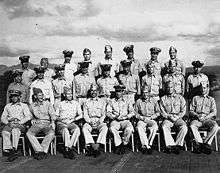
Following the December 7, 1941, attack on Pearl Harbor, Ford enlisted in the navy.[24] He received a commission as ensign in the U.S. Naval Reserve on April 13, 1942. On April 20, he reported for active duty to the V-5 instructor school at Annapolis, Maryland. After one month of training, he went to Navy Preflight School in Chapel Hill, North Carolina, where he was one of 83 instructors and taught elementary navigation skills, ordnance, gunnery, first aid, and military drill. In addition, he coached in all nine sports that were offered, but mostly in swimming, boxing and football. During the year he was at the Preflight School, he was promoted to Lieutenant, Junior Grade, on June 2, 1942, and to lieutenant, in March 1943.
Sea duty
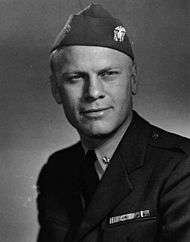
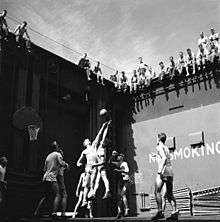
After Ford applied for sea duty, he was sent in May 1943 to the pre-commissioning detachment for the new aircraft carrier USS Monterey (CVL-26), at New York Shipbuilding Corporation, Camden, New Jersey. From the ship's commissioning on June 17, 1943, until the end of December 1944, Ford served as the assistant navigator, Athletic Officer, and antiaircraft battery officer on board the Monterey. While he was on board, the carrier participated in many actions in the Pacific Theater with the Third and Fifth Fleets in late 1943 and 1944. In 1943, the carrier helped secure Makin Island in the Gilberts, and participated in carrier strikes against Kavieng, New Ireland in 1943. During the spring of 1944, the Monterey supported landings at Kwajalein and Eniwetok and participated in carrier strikes in the Marianas, Western Carolines, and northern New Guinea, as well as in the Battle of the Philippine Sea.[25] After an overhaul, from September to November 1944, aircraft from the Monterey launched strikes against Wake Island, participated in strikes in the Philippines and Ryukyus, and supported the landings at Leyte and Mindoro.[25]
Although the ship was not damaged by Japanese forces, the Monterey was one of several ships damaged by the typhoon that hit Admiral William Halsey's Third Fleet on December 18–19, 1944. The Third Fleet lost three destroyers and over 800 men during the typhoon. The Monterey was damaged by a fire, which was started by several of the ship's aircraft tearing loose from their cables and colliding on the hangar deck. During the storm, Ford narrowly avoided becoming a casualty himself. As he was going to his battle station on the bridge of the ship in the early morning of December 18, the ship rolled twenty-five degrees, which caused Ford to lose his footing and slide toward the edge of the deck. The two-inch steel ridge around the edge of the carrier slowed him enough so he could roll, and he twisted into the catwalk below the deck. As he later stated, "I was lucky; I could have easily gone overboard."
Ford was serving as General Quarters Officer of the Deck and was ordered to go below to assess the raging fire. He did so safely, and reported his findings back to the ship's commanding officer, Captain Stuart Ingersoll. The ship's crew was able to contain the fire, and the ship got underway again.[26]
After the fire, the Monterey was declared unfit for service, and the crippled carrier reached Ulithi on December 21 before continuing across the Pacific to Bremerton, Washington where it underwent repairs. On December 24, 1944, at Ulithi, Ford was detached from the ship and sent to the Navy Pre-Flight School at Saint Mary's College of California, where he was assigned to the Athletic Department until April 1945. One of his duties was to coach football. From the end of April 1945 to January 1946, he was on the staff of the Naval Reserve Training Command, Naval Air Station, Glenview, Illinois, as the Staff Physical and Military Training Officer. On October 3, 1945, he was promoted to lieutenant commander.
Ford received the following military awards: the American Campaign Medal, the Asiatic-Pacific Campaign Medal with nine 3⁄16" bronze stars (for operations in the Gilbert Islands, Bismarck Archipelago, Marshall Islands, Asiatic and Pacific carrier raids, Hollandia, Marianas, Western Carolines, Western New Guinea, and the Leyte Operation), the Philippine Liberation Medal with two 3⁄16" bronze stars (for Leyte and Mindoro), and the World War II Victory Medal.[24]
Post-war
In January 1946, Ford was sent to the Separation Center, Great Lakes to be processed out. He was released from active duty under honorable conditions on February 23, 1946. On June 28, 1946, the Secretary of the Navy accepted Ford's resignation from the Naval Reserve. Ford remained in the inactive Naval Reserve until 1963.
Marriage and children
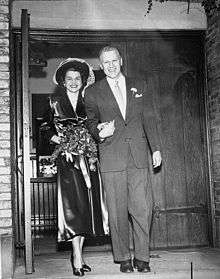
On October 15, 1948, Ford married Elizabeth Bloomer (1918–2011) at Grace Episcopal Church in Grand Rapids; it was his first and only marriage and her second marriage. She had previously been married and, after a five‐year marriage, divorced from William Warren.[27]
Originally from Grand Rapids herself, she had lived in New York City for several years, where she worked as a John Robert Powers fashion model and a dancer in the auxiliary troupe of the Martha Graham Dance Company. At the time of their engagement, Ford was campaigning for what would be his first of 13 terms as a member of the United States House of Representatives. The wedding was delayed until shortly before the election because, as The New York Times reported in a 1974 profile of Betty Ford, "Jerry Ford was running for Congress and wasn't sure how voters might feel about his marrying a divorced exdancer."[27]
The couple had four children:[28]
- Michael Gerald, born in 1950
- John Gardner, known as Jack, born in 1952
- Steven Meigs, born in 1956
- Susan Elizabeth, born in 1957
House of Representatives (1949–1973)
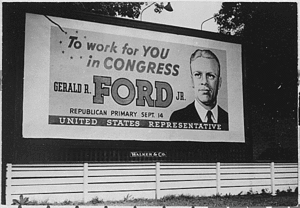
After Ford returned to Grand Rapids in 1946, he became active in local Republican politics, and supporters urged him to challenge Bartel J. Jonkman, the incumbent Republican congressman. Military service had changed his view of the world. "I came back a converted internationalist", Ford wrote, "and of course our congressman at that time was an avowed, dedicated isolationist. And I thought he ought to be replaced. Nobody thought I could win. I ended up winning two to one."[9]
During his first campaign in 1948, Ford visited voters at their doorsteps and as they left the factories where they worked.[29] Ford also visited local farms where, in one instance, a wager resulted in Ford spending two weeks milking cows following his election victory.[30]
Ford was a member of the House of Representatives for 25 years, holding Michigan's 5th congressional district seat from 1949 to 1973. It was a tenure largely notable for its modesty. As an editorial in The New York Times described him, Ford "saw himself as a negotiator and a reconciler, and the record shows it: he did not write a single piece of major legislation in his entire career."[31] Appointed to the House Appropriations Committee two years after being elected, he was a prominent member of the Defense Appropriations Subcommittee. Ford described his philosophy as "a moderate in domestic affairs, an internationalist in foreign affairs, and a conservative in fiscal policy."[32] Ford was known to his colleagues in the House as a "Congressman's Congressman".[33]
In the early 1950s, Ford declined offers to run for either the Senate or the Michigan governorship. Rather, his ambition was to become Speaker of the House,[34] which he called "the ultimate achievement. To sit up there and be the head honcho of 434 other people and have the responsibility, aside from the achievement, of trying to run the greatest legislative body in the history of mankind ... I think I got that ambition within a year or two after I was in the House of Representatives".[35]
Warren Commission
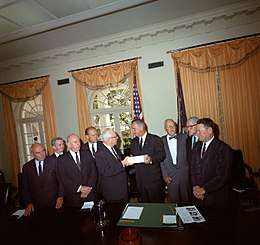
On November 29, 1963, President Lyndon B. Johnson appointed Ford to the Warren Commission, a special task force set up to investigate the assassination of President John F. Kennedy.[36] Ford was assigned to prepare a biography of accused assassin Lee Harvey Oswald. According to a 1963 FBI memo that was released to the public in 2008, Ford was in contact with the FBI throughout his time on the Warren Commission and relayed information to the deputy director, Cartha DeLoach, about the panel's activities.[37][38][39] In the preface to his book, A Presidential Legacy and The Warren Commission, Ford defended the work of the commission and reiterated his support of its conclusions.[40]
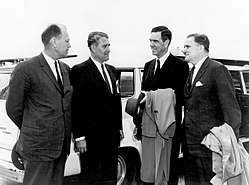
House Minority Leader (1965–1973)
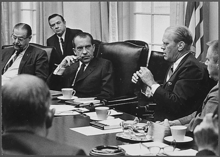
In 1964, Lyndon Johnson led a landslide victory for his party, secured another term as president and took 36 seats from Republicans in the House of Representatives. Following the election, members of the Republican caucus looked to select a new Minority Leader. Three members approached Ford to see if he would be willing to serve; after consulting with his family, he agreed. After a closely contested election, Ford was chosen to replace Charles Halleck of Indiana as Minority Leader.[41]
With a Democratic majority in both the House of Representatives and the Senate, the Johnson Administration proposed and passed a series of programs that was called by Johnson the "Great Society." During the first session of the Eighty-ninth Congress alone, the Johnson Administration submitted 87 bills to Congress, and Johnson signed 84, or 96%, arguably the most successful legislative agenda in Congressional history.[42]
In 1966, criticism over the Johnson Administration's handling of the Vietnam War began to grow, with Ford and Congressional Republicans expressing concern that the United States was not doing what was necessary to win the war. Public sentiment also began to move against Johnson, and the 1966 midterm elections saw a 47-seat swing in favor of the Republicans. This was not enough to give Republicans a majority in the House, but the victory gave Ford the opportunity to prevent the passage of further Great Society programs.[41]
Ford's private criticism of the Vietnam War became public knowledge after he spoke from the floor of the House and questioned whether the White House had a clear plan to bring the war to a successful conclusion.[41] The speech angered President Johnson, who accused Ford of having played "too much football without a helmet".[41][43]
As Minority Leader in the House, Ford appeared in a popular series of televised press conferences with Illinois Senator Everett Dirksen, in which they proposed Republican alternatives to Johnson's policies. Many in the press jokingly called this "The Ev and Jerry Show."[44] Johnson said at the time, "Jerry Ford is so dumb he can't fart and chew gum at the same time."[45] The press, used to sanitizing Johnson's salty language, reported this as "Gerald Ford can't walk and chew gum at the same time."[46]
After Nixon was elected President in November 1968, Ford's role shifted to being an advocate for the White House agenda. Congress passed several of Nixon's proposals, including the National Environmental Policy Act and the Tax Reform Act of 1969. Another high-profile victory for the Republican minority was the State and Local Fiscal Assistance act. Passed in 1972, the act established a Revenue Sharing program for state and local governments.[47] Ford's leadership was instrumental in shepherding revenue sharing through Congress, and resulted in a bipartisan coalition that supported the bill with 223 votes in favor (compared with 185 against).[41][48]
During the eight years (1965–1973) that Ford served as Minority Leader, he won many friends in the House because of his fair leadership and inoffensive personality.[41]
Vice presidency (1973–1974)
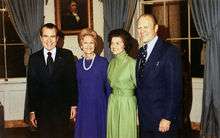
To become House Speaker, Ford worked to help Republicans across the country get a majority in the chamber, often traveling on the rubber chicken circuit. After a decade of failing to do so, he promised his wife that he would try again in 1974 then retire in 1976.[35] On October 10, 1973, Vice President Spiro Agnew resigned and then pleaded no contest to criminal charges of tax evasion and money laundering, part of a negotiated resolution to a scheme in which he accepted $29,500 in bribes while governor of Maryland. According to The New York Times, Nixon "sought advice from senior Congressional leaders about a replacement." The advice was unanimous. "We gave Nixon no choice but Ford," House Speaker Carl Albert recalled later.[31] Ford agreed to the nomination, telling his wife that the Vice Presidency would be "a nice conclusion" to his career.[35]
Ford was nominated to take Agnew's position on October 12, the first time the vice-presidential vacancy provision of the 25th Amendment had been implemented. The United States Senate voted 92 to 3 to confirm Ford on November 27. Only three Senators, all Democrats, voted against Ford's confirmation: Gaylord Nelson of Wisconsin, Thomas Eagleton of Missouri and William Hathaway of Maine. On December 6, 1973, the House confirmed Ford by a vote of 387 to 35. One hour after the confirmation vote in the House, Ford took the oath of office as Vice President of the United States.
Ford became Vice President as the Watergate scandal was unfolding. On Thursday, August 1, 1974, Chief of Staff Alexander Haig contacted Ford to tell him that "smoking gun" evidence had been found. This evidence was an Oval Office tape-recording of Nixon discussing a plan to impede the FBI's investigation by falsely claiming the break-in was a CIA operation. The tape left little doubt that President Nixon had been a part of the Watergate cover-up.
At the time, Ford and his wife, Betty, were living in suburban Virginia, waiting for their expected move into the newly designated vice president's residence in Washington, D.C. However, "Al Haig asked to come over and see me," Ford later said, "to tell me that there would be a new tape released on a Monday, and he said the evidence in there was devastating and there would probably be either an impeachment or a resignation. And he said, 'I'm just warning you that you've got to be prepared, that things might change dramatically and you could become President.' And I said, 'Betty, I don't think we're ever going to live in the vice president's house.'"[9]
Presidency (1974–1977)
Swearing-in

When Nixon resigned on August 9, 1974, Ford automatically assumed the presidency. This made him the only person to become the nation's chief executive without having been previously voted into either the presidential or vice presidential office. Immediately after Ford took the oath of office in the East Room of the White House, he spoke to the assembled audience in a speech that was broadcast live to the nation.[49] Ford noted the peculiarity of his position: "I am acutely aware that you have not elected me as your president by your ballots, and so I ask you to confirm me as your president with your prayers."[50] He went on to state:
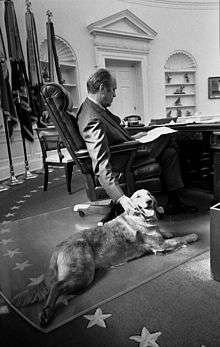
I have not sought this enormous responsibility, but I will not shirk it. Those who nominated and confirmed me as Vice President were my friends and are my friends. They were of both parties, elected by all the people and acting under the Constitution in their name. It is only fitting then that I should pledge to them and to you that I will be the President of all the people.[51]
He also stated:
My fellow Americans, our long national nightmare is over. Our Constitution works; our great Republic is a government of laws and not of men. Here, the people rule. But there is a higher Power, by whatever name we honor Him, who ordains not only righteousness but love, not only justice, but mercy. ... let us restore the golden rule to our political process, and let brotherly love purge our hearts of suspicion and hate.[52]
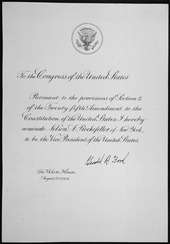
A portion of the speech would later be memorialized with a plaque at the entrance to his presidential museum.
On August 20, Ford nominated former New York Governor Nelson Rockefeller to fill the vice presidency he had vacated.[53] Rockefeller's top competitor had been George H. W. Bush. Rockefeller underwent extended hearings before Congress, which caused embarrassment when it was revealed he made large gifts to senior aides, such as Henry Kissinger. Although conservative Republicans were not pleased that Rockefeller was picked, most of them voted for his confirmation, and his nomination passed both the House and Senate. Some, including Barry Goldwater, voted against him.[54]
Pardon of Nixon
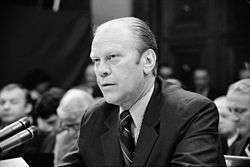
| Wikisource has original text related to this article: |
On September 8, 1974, Ford issued Proclamation 4311, which gave Nixon a full and unconditional pardon for any crimes he might have committed against the United States while president.[55][56][57] In a televised broadcast to the nation, Ford explained that he felt the pardon was in the best interests of the country, and that the Nixon family's situation "is a tragedy in which we all have played a part. It could go on and on and on, or someone must write the end to it. I have concluded that only I can do that, and if I can, I must."[58]
Ford's decision to pardon Nixon was highly controversial. Critics derided the move and said a "corrupt bargain" had been struck between the men.[9] They said that Ford's pardon was granted in exchange for Nixon's resignation, which had elevated Ford to the presidency. Ford's first press secretary and close friend Jerald terHorst resigned his post in protest after the pardon. According to Bob Woodward, Nixon Chief of Staff Alexander Haig proposed a pardon deal to Ford. He later decided to pardon Nixon for other reasons, primarily the friendship he and Nixon shared.[59] Regardless, historians believe the controversy was one of the major reasons Ford lost the 1976 presidential election, an observation with which Ford agreed.[59] In an editorial at the time, The New York Times stated that the Nixon pardon was a "profoundly unwise, divisive and unjust act" that in a stroke had destroyed the new president's "credibility as a man of judgment, candor and competence".[31] On October 17, 1974, Ford testified before Congress on the pardon. He was the first sitting president since Abraham Lincoln to testify before the House of Representatives.[60][61]
In the months following the pardon, Ford often declined to mention President Nixon by name, referring to him in public as "my predecessor" or "the former president." When, on a 1974 trip to California, White House correspondent Fred Barnes pressed Ford on the matter, Ford replied in a surprisingly frank manner: "I just can’t bring myself to do it."[62]
After Ford left the White House in January 1977, he privately justified his pardon of Nixon by carrying in his wallet a portion of the text of Burdick v. United States, a 1915 U.S. Supreme Court decision which stated that a pardon indicated a presumption of guilt, and that acceptance of a pardon was tantamount to a confession of that guilt.[63] In 2001, the John F. Kennedy Library Foundation awarded the John F. Kennedy Profile in Courage Award to Ford for his pardon of Nixon.[64] In presenting the award to Ford, Senator Edward Kennedy said that he had initially been opposed to the pardon, but later decided that history had proved Ford to have made the correct decision.[65]
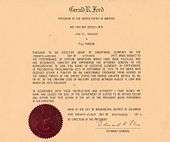
Draft dodgers and deserters
On September 16 (shortly after he pardoned Nixon), Ford issued Presidential Proclamation 4313, which introduced a conditional amnesty program for military deserters and Vietnam War draft dodgers who had fled to countries such as Canada. The conditions of the amnesty required that those reaffirm their allegiance to the United States and serve two years working in a public service job or a total of two years service for those who had served less than two years of honorable service in the military.[66] The program for the Return of Vietnam Era Draft Evaders and Military Deserters[67] established a Clemency Board to review the records and make recommendations for receiving a Presidential Pardon and a change in Military discharge status. Full pardon for draft dodgers came in the Carter administration.[68]
Administration
When Ford assumed office, he inherited Nixon's Cabinet. During his brief administration, he replaced all members except Secretary of State Kissinger and Secretary of the Treasury William E. Simon. Political commentators have referred to Ford's dramatic reorganization of his Cabinet in the fall of 1975 as the "Halloween Massacre". One of Ford's appointees, William Coleman—the Secretary of Transportation—was the second black man to serve in a presidential cabinet (after Robert C. Weaver) and the first appointed in a Republican administration.[69]
Ford selected George H. W. Bush as Chief of the US Liaison Office to the People's Republic of China in 1974, and then Director of the Central Intelligence Agency in late 1975.[70]
Ford's transition chairman and first Chief of Staff was former congressman and ambassador Donald Rumsfeld. In 1975, Rumsfeld was named by Ford as the youngest-ever Secretary of Defense. Ford chose a young Wyoming politician, Richard Cheney, to replace Rumsfeld as his new Chief of Staff; Cheney became the campaign manager for Ford's 1976 presidential campaign.[71]
Midterm elections
.jpg)
The 1974 Congressional midterm elections took place in the wake of the Watergate scandal and less than three months after Ford assumed office. The Democratic Party turned voter dissatisfaction into large gains in the House elections, taking 49 seats from the Republican Party, increasing their majority to 291 of the 435 seats. This was one more than the number needed (290) for a two-thirds majority, the number necessary to override a Presidential veto or to propose a constitutional amendment. Perhaps due in part to this fact, the 94th Congress overrode the highest percentage of vetoes since Andrew Johnson was President of the United States (1865–1869).[72] Even Ford's former, reliably Republican House seat was won by a Democrat, Richard Vander Veen, who defeated Robert VanderLaan. In the Senate elections, the Democratic majority became 61 in the 100-seat body.[73]
Domestic policy
Inflation
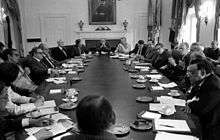
The economy was a great concern during the Ford administration. One of the first acts the new president took to deal with the economy was to create, by Executive Order on September 30, 1974, the Economic Policy Board.[74] In October 1974, in response to rising inflation, Ford went before the American public and asked them to "Whip Inflation Now". As part of this program, he urged people to wear "WIN" buttons.[75] At the time, inflation was believed to be the primary threat to the economy, more so than growing unemployment; there was a belief that controlling inflation would help reduce unemployment.[74] To rein in inflation, it was necessary to control the public's spending. To try to mesh service and sacrifice, "WIN" called for Americans to reduce their spending and consumption.[76] On October 4, 1974, Ford gave a speech in front of a joint session of Congress; as a part of this speech he kicked off the "WIN" campaign. Over the next nine days 101,240 Americans mailed in "WIN" pledges.[74] In hindsight, this was viewed as simply a public relations gimmick which had no way of solving the underlying problems.[77] The main point of that speech was to introduce to Congress a one-year, five-percent income tax increase on corporations and wealthy individuals. This plan would also take $4.4 billion out of the budget, bringing federal spending below $300 billion.[78] At the time, inflation was over twelve percent.[79]
Budget
The federal budget ran a deficit every year Ford was President.[80] Despite his reservations about how the program ultimately would be funded in an era of tight public budgeting, Ford signed the Education for All Handicapped Children Act of 1975, which established special education throughout the United States. Ford expressed "strong support for full educational opportunities for our handicapped children" according to the official White House press release for the bill signing.[81]
The economic focus began to change as the country sank into the worst recession since the Great Depression four decades earlier.[82] The focus of the Ford administration turned to stopping the rise in unemployment, which reached nine percent in May 1975.[83] In January 1975, Ford proposed a 1-year tax reduction of $16 billion to stimulate economic growth, along with spending cuts to avoid inflation.[78] Ford was criticized greatly for quickly switching from advocating a tax increase to a tax reduction. In Congress, the proposed amount of the tax reduction increased to $22.8 billion in tax cuts and lacked spending cuts.[74] In March 1975, Congress passed, and Ford signed into law, these income tax rebates as part of the Tax Reduction Act of 1975. This resulted in a federal deficit of around $53 billion for the 1975 fiscal year and $73.7 billion for 1976.[84]
When New York City faced bankruptcy in 1975, Mayor Abraham Beame was unsuccessful in obtaining Ford's support for a federal bailout. The incident prompted the New York Daily News' famous headline "Ford to City: Drop Dead", referring to a speech in which "Ford declared flatly ... that he would veto any bill calling for 'a federal bail-out of New York City'".[85][86]
Swine flu
Ford was confronted with a potential swine flu pandemic. In the early 1970s, an influenza strain H1N1 shifted from a form of flu that affected primarily pigs and crossed over to humans. On February 5, 1976, an army recruit at Fort Dix mysteriously died and four fellow soldiers were hospitalized; health officials announced that "swine flu" was the cause. Soon after, public health officials in the Ford administration urged that every person in the United States be vaccinated.[87] Although the vaccination program was plagued by delays and public relations problems, some 25% of the population was vaccinated by the time the program was canceled in December 1976. The vaccine was blamed for twenty-five deaths; more people died from the shots than from the swine flu.[88]
Other domestic issues
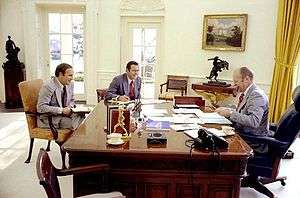
Ford was an outspoken supporter of the Equal Rights Amendment, issuing Presidential Proclamation no. 4383 in 1975:
In this Land of the Free, it is right, and by nature it ought to be, that all men and all women are equal before the law.
Now, therefore, I, Gerald R. Ford, President of the United States of America, to remind all Americans that it is fitting and just to ratify the Equal Rights Amendment adopted by the Congress of the United States of America, in order to secure legal equality for all women and men, do hereby designate and proclaim August 26, 1975, as Women's Equality Day.[89]
As president, Ford's position on abortion was that he supported "a federal constitutional amendment that would permit each one of the 50 States to make the choice".[90] This had also been his position as House Minority Leader in response to the 1973 Supreme Court case of Roe v. Wade, which he opposed.[91] Ford came under criticism for a 60 Minutes interview his wife Betty gave in 1975, in which she stated that Roe v. Wade was a "great, great decision".[92] During his later life, Ford would identify as pro-choice.[93]
Foreign policy
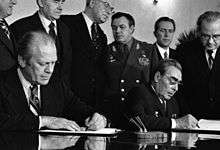
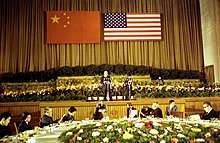
Ford continued the détente policy with both the Soviet Union and China, easing the tensions of the Cold War. Still in place from the Nixon administration was the Strategic Arms Limitation Treaty (SALT).[94] The thawing relationship brought about by Nixon's visit to China was reinforced by Ford's December 1975 visit to that communist country.[95] In 1975, the Administration entered into the Helsinki Accords[96] with the Soviet Union, creating the framework of the Helsinki Watch, an independent non-governmental organization created to monitor compliance that later evolved into Human Rights Watch.[97]
Ford attended the inaugural meeting of the Group of Seven (G7) industrialized nations (initially the G5) in 1975 and secured membership for Canada. Ford supported international solutions to issues. "We live in an interdependent world and, therefore, must work together to resolve common economic problems," he said in a 1974 speech.[98]
According to internal White House and Commission documents posted in February 2016 by the National Security Archive at The George Washington University,[99] the Gerald Ford White House significantly altered the final report of the supposedly independent 1975 Rockefeller Commission investigating CIA domestic activities, over the objections of senior Commission staff. The changes included removal of an entire 86-page section on CIA assassination plots and numerous edits to the report by then-deputy White House Chief of Staff Richard Cheney.[100]
Middle East
In the Middle East and eastern Mediterranean, two ongoing international disputes developed into crises. The Cyprus dispute turned into a crisis with the Turkish invasion of Cyprus, causing extreme strain within the North Atlantic Treaty Organization (NATO) alliance. In mid-August, the Greek government withdrew Greece from the NATO military structure; in mid-September 1974, the Senate and House of Representatives overwhelmingly voted to halt military aid to Turkey. Ford, concerned with both the effect of this on Turkish-American relations and the deterioration of security on NATO's eastern front, vetoed the bill. A second bill was then passed by Congress, which Ford also vetoed, although a compromise was accepted to continue aid until the end of the year.[2] As Ford expected, Turkish relations were considerably disrupted until 1978.
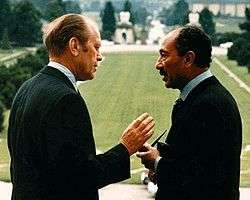
In the continuing Arab–Israeli conflict, although the initial cease fire had been implemented to end active conflict in the Yom Kippur War, Kissinger's continuing shuttle diplomacy was showing little progress. Ford considered it "stalling" and wrote, "Their [Israeli] tactics frustrated the Egyptians and made me mad as hell."[101] During Kissinger's shuttle to Israel in early March 1975, a last minute reversal to consider further withdrawal, prompted a cable from Ford to Prime Minister Yitzhak Rabin, which included:
I wish to express my profound disappointment over Israel's attitude in the course of the negotiations ... Failure of the negotiation will have a far reaching impact on the region and on our relations. I have given instructions for a reassessment of United States policy in the region, including our relations with Israel, with the aim of ensuring that overall American interests ... are protected. You will be notified of our decision.[102]
On March 24, Ford informed congressional leaders of both parties of the reassessment of the administration policies in the Middle East. "Reassessment", in practical terms, meant canceling or suspending further aid to Israel. For six months between March and September 1975, the United States refused to conclude any new arms agreements with Israel. Rabin notes it was "an innocent-sounding term that heralded one of the worst periods in American-Israeli relations".[103] The announced reassessments upset the American Jewish community and Israel's well-wishers in Congress. On May 21, Ford "experienced a real shock" when seventy-six U.S. senators wrote him a letter urging him to be "responsive" to Israel's request for $2.59 billion (equivalent to $11.78 billion in 2017) in military and economic aid. Ford felt truly annoyed and thought the chance for peace was jeopardized. It was, since the September 1974 ban on arms to Turkey, the second major congressional intrusion upon the President's foreign policy prerogatives.[104] The following summer months were described by Ford as an American-Israeli "war of nerves" or "test of wills".[105] After much bargaining, the Sinai Interim Agreement (Sinai II), was formally signed on September 1, and aid resumed.
Vietnam
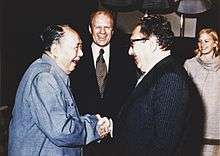
One of Ford's greatest challenges was dealing with the continuing Vietnam War. American offensive operations against North Vietnam had ended with the Paris Peace Accords, signed on January 27, 1973. The accords declared a cease fire across both North and South Vietnam, and required the release of American prisoners of war. The agreement guaranteed the territorial integrity of Vietnam and, like the Geneva Conference of 1954, called for national elections in the North and South. The Paris Peace Accords stipulated a sixty-day period for the total withdrawal of U.S. forces.[106]
The accords had been negotiated by United States National Security Advisor Kissinger and North Vietnamese politburo member Lê Đức Thọ. South Vietnamese President Nguyen Van Thieu was not involved in the final negotiations, and publicly criticized the proposed agreement. However, anti-war pressures within the United States forced Nixon and Kissinger to pressure Thieu to sign the agreement and enable the withdrawal of American forces. In multiple letters to the South Vietnamese president, Nixon had promised that the United States would defend Thieu's government, should the North Vietnamese violate the accords.[107]
In December 1974, months after Ford took office, North Vietnamese forces invaded the province of Phuoc Long. General Trần Văn Trà sought to gauge any South Vietnamese or American response to the invasion, as well as to solve logistical issues, before proceeding with the invasion.[108]
As North Vietnamese forces advanced, Ford requested Congress approve a $722 million aid package for South Vietnam, funds that had been promised by the Nixon administration. Congress voted against the proposal by a wide margin.[94] Senator Jacob K. Javits offered "...large sums for evacuation, but not one nickel for military aid".[94] President Thieu resigned on April 21, 1975, publicly blaming the lack of support from the United States for the fall of his country.[109] Two days later, on April 23, Ford gave a speech at Tulane University. In that speech, he announced that the Vietnam War was over "...as far as America is concerned".[107] The announcement was met with thunderous applause.[107]
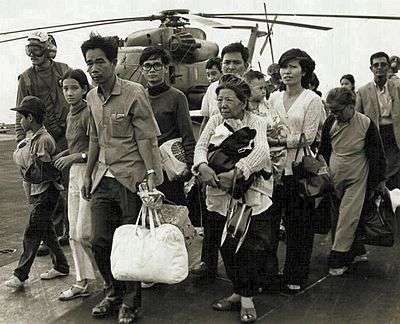
1,373 U.S. citizens and 5,595 Vietnamese and third country nationals were evacuated from the South Vietnamese capital of Saigon during Operation Frequent Wind. In that operation, military and Air America helicopters took evacuees to U.S. Navy ships off-shore during an approximately 24-hour period on April 29 to 30, 1975, immediately preceding the fall of Saigon. During the operation, so many South Vietnamese helicopters landed on the vessels taking the evacuees that some were pushed overboard to make room for more people. Other helicopters, having nowhere to land, were deliberately crash landed into the sea after dropping off their passengers, close to the ships, their pilots bailing out at the last moment to be picked up by rescue boats.[110]
Many of the Vietnamese evacuees were allowed to enter the United States under the Indochina Migration and Refugee Assistance Act. The 1975 Act appropriated $455 million toward the costs of assisting the settlement of Indochinese refugees.[111] In all, 130,000 Vietnamese refugees came to the United States in 1975. Thousands more escaped in the years that followed.[112]
Mayaguez and Panmunjom
North Vietnam's victory over the South led to a considerable shift in the political winds in Asia, and Ford administration officials worried about a consequent loss of U.S. influence there. The administration proved it was willing to respond forcefully to challenges to its interests in the region on two occasions, once when Khmer Rouge forces seized an American ship in international waters and again when American military officers were killed in the demilitarized zone (DMZ) between North and South Korea.[113]
The first crisis was the Mayaguez incident. In May 1975, shortly after the fall of Saigon and the Khmer Rouge conquest of Cambodia, Cambodians seized the American merchant ship Mayaguez in international waters.[114] Ford dispatched Marines to rescue the crew, but the Marines landed on the wrong island and met unexpectedly stiff resistance just as, unknown to the U.S., the Mayaguez sailors were being released. In the operation, two military transport helicopters carrying the Marines for the assault operation were shot down, and 41 U.S. servicemen were killed and 50 wounded while approximately 60 Khmer Rouge soldiers were killed.[115] Despite the American losses, the operation was seen as a success in the United States and Ford enjoyed an 11-point boost in his approval ratings in the aftermath.[116] The Americans killed during the operation became the last to have their names inscribed on the Vietnam Veterans Memorial wall in Washington, D.C.
Some historians have argued that the Ford administration felt the need to respond forcefully to the incident because it was construed as a Soviet plot.[117] But work by Andrew Gawthorpe, published in 2009, based on an analysis of the administration's internal discussions, shows that Ford's national security team understood that the seizure of the vessel was a local, and perhaps even accidental, provocation by an immature Khmer government. Nevertheless, they felt the need to respond forcefully to discourage further provocations by other Communist countries in Asia.[118]
The second crisis, known as the axe murder incident, occurred at Panmunjom, a village which stands in the DMZ between the two Koreas. Encouraged by U.S. difficulties in Vietnam, North Korea had been waging a campaign of diplomatic pressure and minor military harassment to try to convince the U.S. to withdraw from South Korea.[119] Then, in August 1976, North Korean forces killed two U.S. officers and injured South Korean guards who were engaged in trimming a tree in Panmunjom's Joint Security Area. The attack coincided with a meeting of the Conference of Non-Aligned Nations in Colombo, Sri Lanka, at which Kim Jong-il, the son of North Korean leader Kim Il-sung, presented the incident as an example of American aggression, helping secure the passage of a motion calling for a U.S. withdrawal from the South.[120]
At administration meetings, Kissinger voiced the concern that the North would see the U.S. as "the paper tigers of Saigon" if they did not respond, and Ford agreed with that assessment. After mulling various options the Ford administration decided that it was necessary to respond with a major show of force. A large number of ground forces went to cut down the tree, while at the same time the air force was deployed, which included B-52 bomber flights over Panmunjom. The North Korean government backed down and allowed the tree-cutting to go ahead, and later issued an unprecedented official apology.[121]
Indonesian invasion of East Timor
East Timor's decolonization due to political instability in Portugal saw Indonesia posture to annex the new state in 1975. Just hours before the Indonesian invasion of East Timor (now Timor Leste) on December 7, 1975, Ford and Kissinger had visited Indonesian President Suharto in Jakarta and guaranteed American compliance with the Indonesian operation. Suharto had been a key supporter of American influence in Indonesia and Southeast Asia and Ford did not desire to place pressure on the American-Indonesian relationship.[122]
Under Ford, a policy of arms sales to the Suharto regime began in 1975, before the invasion. "Roughly 90%" of the Indonesian army's weapons at the time of East Timor's invasion were provided by the U.S. according to George H. Aldrich, a former State Department deputy legal advisor.[123] Post-invasion, Ford's military aid averaged about $30 million annually throughout East Timor's occupation, and arms sales increased exponentially under President Carter. This policy continued until 1999.[124]
Assassination attempts
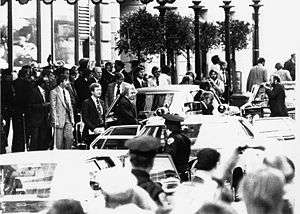
Ford was the target of two assassination attempts during his presidency. In Sacramento, California, on September 5, 1975, Lynette "Squeaky" Fromme, a follower of Charles Manson, pointed a Colt .45-caliber handgun at Ford and pulled the trigger at point-blank range.[28][125] As she did, Larry Buendorf,[126] a Secret Service agent, grabbed the gun, and Fromme was taken into custody. She was later convicted of attempted assassination of the President and was sentenced to life in prison; she was paroled on August 14, 2009, after serving 34 years.[127]
In reaction to this attempt, the Secret Service began keeping Ford at a more secure distance from anonymous crowds, a strategy that may have saved his life seventeen days later. As he left the St. Francis Hotel in downtown San Francisco, Sara Jane Moore, standing in a crowd of onlookers across the street, fired a .38-caliber revolver at him. The shot missed Ford by a few feet.[28][128] Before she fired a second round, retired Marine Oliver Sipple grabbed at the gun and deflected her shot; the bullet struck a wall about six inches above and to the right of Ford's head, then ricocheted and hit a taxi driver, who was slightly wounded. Moore was later sentenced to life in prison. She was paroled on December 31, 2007, after serving 32 years.[129]
Judicial appointments
Supreme Court
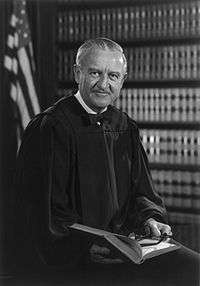
In 1975, Ford appointed John Paul Stevens as Associate Justice of the Supreme Court of the United States to replace retiring Justice William O. Douglas. Stevens had been a judge of the United States Court of Appeals for the Seventh Circuit, appointed by President Nixon.[130] During his tenure as House Republican leader, Ford had led efforts to have Douglas impeached.[131] After being confirmed, Stevens eventually disappointed some conservatives by siding with the Court's liberal wing regarding the outcome of many key issues.[132] Nevertheless, in 2005 Ford praised Stevens. "He has served his nation well," Ford said of Stevens, "with dignity, intellect and without partisan political concerns."[133]
Other judicial appointments
Ford appointed 11 judges to the United States Courts of Appeals, and 50 judges to the United States district courts.[134]
1976 presidential election
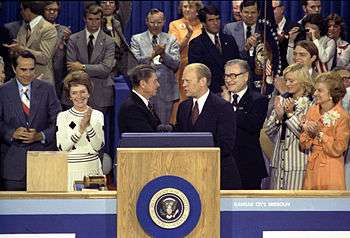
Ford reluctantly agreed to run for office in 1976, but first he had to counter a challenge for the Republican party nomination. Former Governor of California Ronald Reagan and the party's conservative wing faulted Ford for failing to do more in South Vietnam, for signing the Helsinki Accords, and for negotiating to cede the Panama Canal. (Negotiations for the canal continued under President Carter, who eventually signed the Torrijos–Carter Treaties.) Reagan launched his campaign in autumn of 1975 and won numerous primaries, including North Carolina, Texas, Indiana, and California, but failed to get a majority of delegates; Reagan withdrew from the race at the Republican Convention in Kansas City, Missouri. The conservative insurgency did lead to Ford dropping the more liberal Vice President Nelson Rockefeller in favor of U.S. Senator Bob Dole of Kansas.[135]
In addition to the pardon dispute and lingering anti-Republican sentiment, Ford had to counter a plethora of negative media imagery. Chevy Chase often did pratfalls on Saturday Night Live, imitating Ford, who had been seen stumbling on two occasions during his term. As Chase commented, "He even mentioned in his own autobiography it had an effect over a period of time that affected the election to some degree."[136]
Ford's 1976 election campaign benefitted from his being an incumbent president during several anniversary events held during the period leading up to the United States Bicentennial. The Washington, D.C. fireworks display on the Fourth of July was presided over by the President and televised nationally.[137] On July 7, 1976, the President and First Lady served as hosts at a White House state dinner for Queen Elizabeth II and Prince Philip of the United Kingdom, which was televised on the Public Broadcasting Service network. The 200th anniversary of the Battles of Lexington and Concord in Massachusetts gave Ford the opportunity to deliver a speech to 110,000 in Concord acknowledging the need for a strong national defense tempered with a plea for "reconciliation, not recrimination" and "reconstruction, not rancor" between the United States and those who would pose "threats to peace".[138] Speaking in New Hampshire on the previous day, Ford condemned the growing trend toward big government bureaucracy and argued for a return to "basic American virtues".[139]
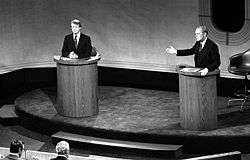
Democratic nominee and former Georgia governor Jimmy Carter campaigned as an outsider and reformer, gaining support from voters dismayed by the Watergate scandal and Nixon pardon. After the Democratic National Convention, he held a huge 33-point lead over Ford in the polls. However, as the campaign continued, the race tightened, and, by election day, the polls showed the race as too close to call. There were three main events in the fall campaign. Most importantly, Carter repeated a promise of a "blanket pardon" for Christian and other religious refugees, and also all Vietnam War draft dodgers (Ford had only issued a conditional amnesty) in response to a question on the subject posed by a reporter during the presidential debates, an act which froze Ford's poll numbers in Ohio, Wisconsin, Hawaii, and Mississippi. (Ford had needed to shift just 11,000 votes in Ohio plus one of the other three in order to win.) It was the first act signed by Carter, on January 20, 1977. Earlier, Playboy magazine had published a controversial interview with Carter; in the interview Carter admitted to having "lusted in my heart" for women other than his wife, which cut into his support among women and evangelical Christians. Also, on September 24, Ford performed well in what was the first televised presidential debate since 1960. Polls taken after the debate showed that most viewers felt that Ford was the winner. Carter was also hurt by Ford's charges that he lacked the necessary experience to be an effective national leader, and that Carter was vague on many issues.
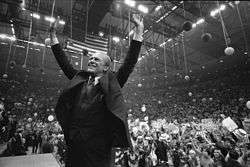
Televised presidential debates were reintroduced for the first time since the 1960 election. As such, Ford became the first incumbent president to participate in one. Carter later attributed his victory in the election to the debates, saying they "gave the viewers reason to think that Jimmy Carter had something to offer". The turning point came in the second debate when Ford blundered by stating, "There is no Soviet domination of Eastern Europe and there never will be under a Ford Administration." Ford also said that he did not "believe that the Poles consider themselves dominated by the Soviet Union".[140] In an interview years later, Ford said he had intended to imply that the Soviets would never crush the spirits of eastern Europeans seeking independence. However, the phrasing was so awkward that questioner Max Frankel was visibly incredulous at the response.[141]
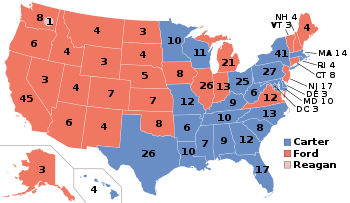
In the end, Carter won the election, receiving 50.1% of the popular vote and 297 electoral votes compared with 48.0% and 240 electoral votes for Ford.[142]
Post-presidency (1977–2006)
Activity
The Nixon pardon controversy eventually subsided. Ford's successor, Jimmy Carter, opened his 1977 inaugural address by praising the outgoing President, saying, "For myself and for our Nation, I want to thank my predecessor for all he has done to heal our land."[143]
After leaving the White House, the Fords moved to Denver, Colorado. Ford successfully invested in oil with Marvin Davis, which later provided an income for Ford's children.[144]
He continued to make appearances at events of historical and ceremonial significance to the nation, such as presidential inaugurals and memorial services. In January 1977, he became the president of Eisenhower Fellowships in Philadelphia, then served as the chairman of its board of trustees from 1980 to 1986.[145] Later in 1977, he reluctantly agreed to be interviewed by James M. Naughton, a New York Times journalist who was given the assignment to write the former President's advance obituary, an article that would be updated prior to its eventual publication.[146] In 1979, Ford published his autobiography, A Time to Heal (Harper/Reader's Digest, 454 pages). A review in Foreign Affairs described it as, "Serene, unruffled, unpretentious, like the author. This is the shortest and most honest of recent presidential memoirs, but there are no surprises, no deep probings of motives or events. No more here than meets the eye."[147]
During the term of office of his successor, Jimmy Carter, Ford received monthly briefs by President Carter's senior staff on international and domestic issues, and was always invited to lunch at the White House whenever he was in Washington, D.C. Their close friendship developed after Carter had left office, with the catalyst being their trip together to the funeral of Anwar el-Sadat in 1981.[148] Until Ford's death, Carter and his wife, Rosalynn, visited the Fords' home frequently.[149] Ford and Carter served as honorary co-chairs of the National Commission on Federal Election Reform in 2001 and of the Continuity of Government Commission in 2002.
Like Presidents Carter, George H. W. Bush, and Clinton, Ford was an honorary co-chair of the Council for Excellence in Government, a group dedicated to excellence in government performance, which provides leadership training to top federal employees. He also devoted much time to his love of golf, often playing both privately and in public events with comedian Bob Hope, a longtime friend. In 1977, he shot a hole in one during a Pro-am held in conjunction with the Danny Thomas Memphis Classic at Colonial Country Club in Memphis, Tennessee. He hosted the Jerry Ford Invitational in Vail, Colorado from 1977 to 1996.
In 1977, Ford established the Gerald R. Ford Institute of Public Policy at Albion College in Albion, Michigan, to give undergraduates training in public policy. In April 1981, he opened the Gerald R. Ford Library in Ann Arbor, Michigan, on the north campus of his alma mater, the University of Michigan,[150] followed in September by the Gerald R. Ford Museum in Grand Rapids.[151][152]
Ford considered a run for the Republican nomination in 1980, forgoing numerous opportunities to serve on corporate boards to keep his options open for a rematch with Carter. Ford attacked Carter's conduct of the SALT II negotiations and foreign policy in the Middle East and Africa. Many have argued that Ford also wanted to exorcise his image as an "Accidental President" and to win a term in his own right. Ford also believed the more conservative Ronald Reagan would be unable to defeat Carter and would hand the incumbent a second term. Ford was encouraged by his former Secretary of State, Henry Kissinger as well as Jim Rhodes of Ohio and Bill Clements of Texas to make the race. On March 15, 1980, Ford announced that he would forgo a run for the Republican nomination, vowing to support the eventual nominee.
-1.jpg)
After securing the Republican nomination in 1980, Ronald Reagan considered his former rival Ford as a potential vice-presidential running mate, but negotiations between the Reagan and Ford camps at the Republican National Convention were unsuccessful. Ford conditioned his acceptance on Reagan's agreement to an unprecedented "co-presidency",[153] giving Ford the power to control key executive branch appointments (such as Kissinger as Secretary of State and Alan Greenspan as Treasury Secretary). After rejecting these terms, Reagan offered the vice-presidential nomination instead to George H. W. Bush.[154] Ford did appear in a campaign commercial for the Reagan-Bush ticket, in which he declared that the country would be "better served by a Reagan presidency rather than a continuation of the weak and politically expedient policies of Jimmy Carter".[155] On October 8, 1980, Ford said President Nixon's involvement in the general election potentially could negatively impact the Reagan campaign: "I think it would have been much more helpful if Mr. Nixon had stayed in the background during this campaign. It would have been much more beneficial to Ronald Reagan."[156]
On October 3, 1980, Ford cast blame on Carter for the latter's charges of ineffectiveness on the part of the Federal Reserve Board due to his appointing of most of its members: "President Carter, when the going gets tough, will do anything to save his own political skin. This latest action by the president is cowardly."[157]
Following the attempted assassination of Ronald Reagan, Ford told reporters while appearing at a fundraiser for Thomas Kean that criminals who use firearms should get the death penalty in the event someone is injured with the weapon.[158]
In September 1981, Ford advised Reagan against succumbing to Wall Street demands and follow his own agenda for the economic policies of the US during an appearance on Good Morning America: "He shouldn't let the gurus of Wall Street decide what the economic future of this country is going to be. They are wrong in my opinion."[159] On October 20, 1981, Ford stated stopping the Reagan administration's Saudi arms package could have a large negative impact to American relations in the Middle East during a news conference.[160]
On March 24, 1982, Ford offered an endorsement of President Reagan's economic policies while also stating the possibility of Reagan being met with a stalemate by Congress if not willing to compromise while in Washington.[161]
Ford founded the annual AEI World Forum in 1982, and joined the American Enterprise Institute as a distinguished fellow. He was also awarded an honorary doctorate at Central Connecticut State University[162] on March 23, 1988.
During an August 1982 fundraising reception, Ford stated his opposition to a constitution amendment requiring the US to have a balanced budget, citing a need to elect "members of the House and Senate who will immediately when Congress convenes act more responsibly in fiscal matters."[163] Ford was a participant in the 1982 midterm elections, traveling to Tennessee in October of that year to help Republican candidates.[164]
In January 1984, a letter signed by Ford and Carter and urging world leaders to extend their failed effort to end world hunger was released and sent to Secretary-General of the United Nations Javier Pérez de Cuéllar.[165]
In 1987, Ford testified before the Senate Judiciary Committee in favor of District of Columbia Circuit Court judge and former Solicitor General Robert Bork after Bork was nominated by President Reagan to be an Associate Justice of the United States Supreme Court.[166] Bork's nomination was rejected by a vote of 58-42.[167]
In 1987 Ford's Humor and the Presidency, a book of humorous political anecdotes, was published.
By 1988, Ford was a member of several corporate boards including Commercial Credit, Nova Pharmaceutical, The Pullman Company, Tesoro Petroleum, and Tiger International, Inc.[168] Ford also became an honorary director of Citigroup, a position he held until his death.[169]
In October 1990, Ford appeared in Gettysburg, Pennsylvania with Bob Hope to commemorate the centennial anniversary of the birth of former President Dwight D. Eisenhower, where the two unveiled a plaque with the signatures of each living former president.[170]
In April 1991, Ford joined former presidents Richard Nixon, Ronald Reagan, and Jimmy Carter, in supporting the Brady Bill.[171] Three years later, he wrote to the U.S. House of Representatives, along with Carter and Reagan, in support of the assault weapons ban.[172]
At the 1992 Republican National Convention, Ford compared the election cycle to his 1976 loss to Carter and urged attention be paid to electing a Republican Congress: "If it's change you want on Nov. 3, my friends, the place to start is not at the White House but in the United States' Capitol. Congress, as every school child knows, has the power of the purse. For nearly 40 years, Democratic majorities have held to the time-tested New Deal formula, tax and tax, spend and spend, elect and elect."[173]
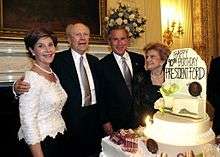
In April 1997, Ford joined President Bill Clinton, former President Bush, and Nancy Reagan in signing the "Summit Declaration of Commitment" in advocating for participation by private citizens in solving domestic issues within the United States.[174]
On January 20, 1998, during an interview at his Palm Springs home, Ford said the Republican Party's nominee in the 2000 presidential election would lose if very conservative in their ideals: "If we get way over on the hard right of the political spectrum, we will not elect a Republican President. I worry about the party going down this ultra-conservative line. We ought to learn from the Democrats: when they were running ultra-liberal candidates, they didn't win."[175]
In the prelude to the impeachment of President Clinton, Ford conferred with former President Carter and the two agreed to not speak publicly on the controversy, a pact broken by Carter when answering a question from a student at Emory University.[176]
In October 2001, Ford broke with conservative members of the Republican Party by stating that gay and lesbian couples "ought to be treated equally. Period." He became the highest ranking Republican to embrace full equality for gays and lesbians, stating his belief that there should be a federal amendment outlawing anti-gay job discrimination and expressing his hope that the Republican Party would reach out to gay and lesbian voters.[177] He also was a member of the Republican Unity Coalition, which The New York Times described as "a group of prominent Republicans, including former President Gerald R. Ford, dedicated to making sexual orientation a non-issue in the Republican Party".[178]
On November 22, 2004, New York Republican Governor George Pataki named Ford and the other living former Presidents (Carter, George H. W. Bush and Bill Clinton) as honorary members of the board rebuilding the World Trade Center.
In a pre-recorded embargoed interview with Bob Woodward of The Washington Post in July 2004, Ford stated that he disagreed "very strongly" with the Bush administration's choice of Iraq's alleged weapons of mass destruction as justification for its decision to invade Iraq, calling it a "big mistake" unrelated to the national security of the United States and indicating that he would not have gone to war had he been President. The details of the interview were not released until after Ford's death, as he requested.[179][180]
Health problems
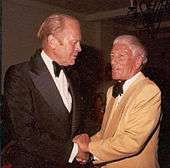
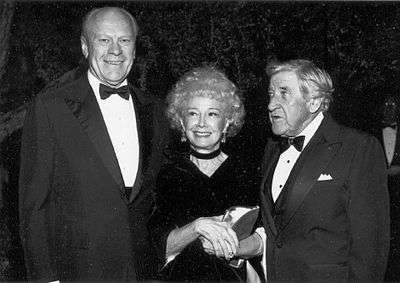
On April 4, 1990, Ford was admitted to Eisenhower Medical Center for surgery to replace his left knee, orthopedic surgeon Dr. Robert Murphy saying "Ford's entire left knee was replaced with an artificial joint, including portions of the adjacent femur, or thigh bone, and tibia, or leg bone."[181]
Ford suffered two minor strokes at the 2000 Republican National Convention, but made a quick recovery after being admitted to Hahnemann University Hospital.[182][183] In January 2006, he spent 11 days at the Eisenhower Medical Center near his residence at Rancho Mirage, California, for treatment of pneumonia.[184] On April 23, 2006, President George W. Bush visited Ford at his home in Rancho Mirage for a little over an hour. This was Ford's last public appearance and produced the last known public photos, video footage, and voice recording.
While vacationing in Vail, Colorado, Ford was hospitalized for two days in July 2006 for shortness of breath.[185] On August 15 he was admitted to St. Mary's Hospital of the Mayo Clinic in Rochester, Minnesota, for testing and evaluation. On August 21, it was reported that he had been fitted with a pacemaker. On August 25, he underwent an angioplasty procedure at the Mayo Clinic. On August 28, Ford was released from the hospital and returned with his wife Betty to their California home. On October 13, he was scheduled to attend the dedication of a building of his namesake, the Gerald R. Ford School of Public Policy at the University of Michigan, but due to poor health and on the advice of his doctors he did not attend. The previous day, Ford had entered the Eisenhower Medical Center for undisclosed tests; he was released on October 16.[186] By November 2006, he was confined to a bed in his study.[187]
Death and legacy

Ford died on December 26, 2006, at his home in Rancho Mirage, California, of arteriosclerotic cerebrovascular disease and diffuse arteriosclerosis. He had end-stage coronary artery disease and severe aortic stenosis and insufficiency, caused by calcific alteration of one of his heart valves.[188] He was 93. Ford died on the 34th anniversary of President Harry S. Truman's death; he was the last surviving member of the Warren Commission.[189]
On December 30, 2006, Ford became the 11th U.S. President to lay in state in the Rotunda of the U.S. Capitol.[190] A state funeral and memorial services was held at the National Cathedral in Washington, D.C., on January 2, 2007. After the service, Ford was interred at his Presidential Museum in Grand Rapids, Michigan.[191]
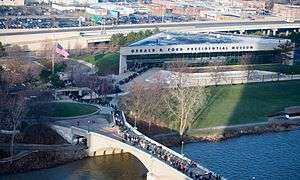
Scouting was so important to Ford that his family asked that Scouts participate in his funeral. A few selected Scouts served as ushers inside the National Cathedral. About 400 Eagle Scouts were part of the funeral procession, where they formed an honor guard as the casket went by in front of the museum.[192]
Ford selected the song to be played during his funeral procession at the U.S. Capitol.[193] After his death in December 2006, the University of Michigan Marching Band played the school's fight song for him one final time, for his last ride from the Gerald R. Ford Airport in Grand Rapids, Michigan.[194]
The State of Michigan commissioned and submitted a statue of Ford to the National Statuary Hall Collection, replacing Zachariah Chandler. It was unveiled on May 3, 2011 in the Capitol Rotunda. On the proper right side is inscribed a quotation from a tribute by Thomas P. "Tip" O'Neill, Speaker of the House at the end of Ford's presidency: "God has been good to America, especially during difficult times. At the time of the Civil War, he gave us Abraham Lincoln. And at the time of Watergate, he gave us Gerald Ford—the right man at the right time who was able to put our nation back together again." On the proper left side are words from Ford's swearing-in address: "Our constitution works. Our great republic is a government of laws and not of men. Here the people rule."
Ford's wife, Betty Ford, died on July 8, 2011.[195] Like her husband, she was 93 years old when she died.
Longevity
On November 12, 2006, Ford surpassed the 93 years and 120 days lifespan of Ronald Reagan, who died on June 5, 2004. He released his last public statement:
The length of one's days matters less than the love of one's family and friends. I thank God for the gift of every sunrise and, even more, for all the years He has blessed me with Betty and the children; with our extended family and the friends of a lifetime. That includes countless Americans who, in recent months, have remembered me in their prayers. Your kindness touches me deeply. May God bless you all and may God bless America.[196]
At the time of his death, Ford was the longest-lived President, having lived 93 years and 165 days (45 days longer than Ronald Reagan, whose record he surpassed).[35][197]
Public image
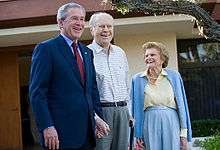
Ford was the only person to hold the presidential office without being elected as either president or vice president. The choice of Ford to fulfill Spiro Agnew's vacated role as vice president was based on Ford's reputation for openness and honesty.[198] "In all the years I sat in the House, I never knew Mr. Ford to make a dishonest statement nor a statement part-true and part-false. He never attempted to shade a statement, and I never heard him utter an unkind word," said Martha Griffiths.[199]
The trust the American people had in him was rapidly and severely tarnished by his pardon of Nixon.[199] Nonetheless, many grant in hindsight that he had respectably discharged with considerable dignity a great responsibility that he had not sought.[199] His subsequent loss to Carter in 1976 has come to be seen as an honorable sacrifice he made for the nation.[198]
In spite of his athletic record and remarkable career accomplishments, Ford acquired a reputation as a clumsy, likable, and simple-minded Everyman. An incident in 1975, when he tripped while exiting Air Force One in Austria, was famously and repeatedly parodied by Chevy Chase, cementing Ford's image as a klutz.[199][200][201] Pieces of Ford's common Everyman image have also been attributed to Ford's inevitable comparison to Nixon, as well as his perceived Midwestern stodginess and self-deprecation.[198]
Civic and fraternal organizations
Ford was a member of several civic organizations, including the Junior Chamber of Commerce (Jaycees), American Legion, AMVETS, Benevolent and Protective Order of Elks, Sons of the Revolution,[202] and Veterans of Foreign Wars.
Freemasonry
Ford was initiated into Freemasonry on September 30, 1949.[203] He later said in 1975, "When I took my obligation as a master mason—incidentally, with my three younger brothers—I recalled the value my own father attached to that order. But I had no idea that I would ever be added to the company of the Father of our Country and 12 other members of the order who also served as Presidents of the United States."[204] Ford was made a 33° Scottish Rite Mason on September 26, 1962.[205] In April 1975, Ford was elected by a unanimous vote Honorary Grand Master of the International Supreme Council, Order of DeMolay, a position in which he served until January 1977.[206] Ford received the degrees of York Rite Masonry (Chapter and Council degrees) in a special ceremony in the Oval Office on January 11, 1977, during his term as President of the United States.[207]
Honors
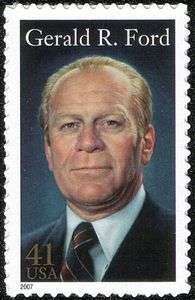
Ford received the Distinguished Eagle Scout Award in May 1970, as well as the Silver Buffalo Award, from the Boy Scouts of America. In 1974, he also received the highest distinction of the Scout Association of Japan, the Golden Pheasant Award.[208] In 1985, he received the 1985 Old Tom Morris Award from the Golf Course Superintendents Association of America, GCSAA's highest honor.[209] In 1992, the U.S. Navy Memorial Foundation awarded Ford its Lone Sailor Award for his naval service and his subsequent government service. In 1999, Ford was honored with a Golden Palm Star on the Palm Springs Walk of Stars.[210] Also in 1999, Ford was awarded the Presidential Medal of Freedom by Bill Clinton.[211] In 2001, he was presented with the John F. Kennedy Profiles in Courage Award for his decision to pardon Richard Nixon to stop the agony America was experiencing over Watergate.[212]
The following were named after Ford:
- The Ford House Office Building in the U.S. Capitol Complex, formerly House Annex 2.
- Gerald R. Ford Freeway (Nebraska)
- Gerald R. Ford Freeway (Michigan)
- Gerald Ford Memorial Highway, I-70 in Eagle County, Colorado
- Gerald R. Ford International Airport in Grand Rapids, Michigan
- Gerald R. Ford Library in Ann Arbor, Michigan
- Gerald R. Ford Museum in Grand Rapids, Michigan
- Gerald R. Ford School of Public Policy, University of Michigan
- Gerald R. Ford Institute of Public Policy, Albion College
- USS Gerald R. Ford (CVN-78)
- Gerald R. Ford Middle School, Grand Rapids, Michigan[213]
- President Gerald R. Ford Park in Alexandria, Virginia, located in the neighborhood where Ford[214] lived while serving as a Representative and Vice President
- President Ford Field Service Council, Boy Scouts of America The council where he was awarded the rank of Eagle Scout. Serves 25 counties in Western and Northern Michigan with its headquarters located in Grand Rapids, Michigan.[215]
See also
References
- ↑ Frum, David (2000). How We Got Here: The '70s. New York City: Basic Books. pp. xxiii, 301. ISBN 978-0-465-04195-4.
- 1 2 George Lenczowski (1990). American Presidents, and the Middle East. Duke University Press. pp. 142–143. ISBN 978-0-8223-0972-7.
- ↑ Young, Jeff C. (1997). The Fathers of American Presidents. Jefferson, NC: McFarland & Co. ISBN 978-0-7864-0182-6.
- 1 2 Funk, Josh (December 27, 2006). "Nebraska-born Ford Left State as Infant". Fox News. Associated Press. Archived from the original on April 29, 2011. Retrieved September 2, 2009.
- ↑ Cannon, James. "Gerald R. Ford". Character Above All. Public Broadcasting System. Retrieved December 28, 2006.
- ↑ "Gerald R. Ford Genealogical Information". Gerald R. Ford Presidential Library & Museum. University of Texas. Retrieved December 28, 2006.
- ↑ "Richard Ford remembered as active steward of President Gerald Ford's legacy". MLive. March 20, 2015. Retrieved December 21, 2015.
- ↑ "A Common Man on an Uncommon Climb" (PDF). The New York Times. August 19, 1976. p. 28. Retrieved April 26, 2009.
- 1 2 3 4 5 Kunhardt Jr., Phillip (1999). Gerald R. Ford "Healing the Nation". New York: Riverhead Books. pp. 79–85. Retrieved December 28, 2006.
- 1 2 Townley, Alvin (2007) [December 26, 2006]. Legacy of Honor: The Values and Influence of America's Eagle Scouts. New York: St. Martin's Press. pp. 12–13 and 87. ISBN 978-0-312-36653-7. Retrieved December 29, 2006.
- ↑ "Investigatory Records on Gerald Ford, Applicant for a Commission" (PDF). Gerald R. Ford Presidential Library. December 30, 1941. Retrieved November 18, 2010.
- ↑ Wertheimer, Linda (December 27, 2006). "Special Report: Former President Gerald Ford Dies; Sought to Heal Nation Disillusioned by Watergate Scandal". National Public Radio. Retrieved April 26, 2009.
- ↑ Perry, Will (1974). "No Cheers From the Alumni". The Wolverines: A Story of Michigan Football (PDF). Huntsville, Alabama: The Strode Publishers. pp. 150–152. ISBN 978-0-87397-055-6. Retrieved December 28, 2006.
- ↑ Kruger, Brian; Moorehouse, Buddy (August 9, 2012). "Willis Ward, Gerald Ford and Michigan Football's darkest day". The Detroit News. Retrieved October 22, 2012.
- ↑ Greene, J.R. (1995). The Presidency of Gerald R. Ford (American Presidency Series). University Press of Kansas. p. 2. ISBN 978-0-7006-0638-2.
- ↑ "Ford Named Michigan Football Legend; Morgan to Wear No. 48 Jersey".
- ↑ "Clumsy image aside, Ford was Accomplished Athlete". Los Angeles Times. December 28, 2006. Retrieved September 2, 2009.
- ↑ Rozell, Mark J. (October 15, 1992). The Press and the Ford Presidency. University of Michigan Press. p. 38. ISBN 978-0-472-10350-8.
- 1 2 "Timeline of President Ford's Life and Career". Gerald R. Ford Presidential Library & Museum. Retrieved December 28, 2006.
- ↑ Wendy Wolff (1997). Vice Presidents of the United States 1789–1993. United States Government Printing Office.
- ↑ "The U-M Remembers Gerald R. Ford". The University of Michigan. Retrieved January 2, 2007.
- ↑ "Gerald R. Ford Biography". Gerald R. Ford Presidential Library & Museum. Retrieved January 2, 2007.
- ↑ Doenecke, Justus D. (1990). "In Danger Undaunted: The Anti-Interventionist Movement of 1940–1941 As Revealed in the Papers of the America First Committee (Hoover Archival Documentaries)". Hoover Institution Press. Retrieved December 28, 2006. p. 7
- 1 2 Hove, Duane (2003). American Warriors: Five Presidents in the Pacific Theater of World War II. Burd Street Press. ISBN 978-1-57249-307-0.
- ↑ "Lieutenant Gerald Ford and Typhoon Cobra". Naval Historical Foundation. February 7, 2013. Retrieved February 8, 2013.
- 1 2 Howard, Jane (December 8, 1974). "The 38th First Lady: Not a Robot At All". The New York Times. Retrieved June 30, 2018 – via The TimesMachine archive viewer.
- 1 2 3 Greene, John Robert. "Gerald Ford: Family Life". Charlottesville, Virginia: Miller Center of Public Affairs, University of Virginia. Retrieved March 25, 2018.
- ↑ Winget, Mary Mueller (2007). Gerald R. Ford. Twenty-First Century Books. ISBN 978-0-8225-1509-8. Retrieved September 3, 2009.
- ↑ Kruse, Melissa (January 3, 2003). "The Patterson Barn, Grand Rapids, Michigan—Barn razing erases vintage landmark". The Grand Rapids Press. p. D1. Archived from the original on April 29, 2011. Retrieved September 3, 2009.
- 1 2 3 "Gerald R. Ford". The New York Times. December 28, 2006. Retrieved December 29, 2006.
- ↑ "Gerald R. Ford". The White House. Retrieved October 25, 2009.
- ↑ Celebrating the life of President Gerald R. Ford on what would have been his 96th birthday, H.R. 409, 111th Congress, 1st Session (2009).
- ↑ "Gerald R. Ford Presidential Library and Museum". Ford.utexas.edu. Retrieved August 9, 2009.
- 1 2 3 4 James M. Naughton; Adam Clymer (December 27, 2006). "Gerald Ford, 38th President, Dies at 93". The New York Times. Retrieved October 19, 2009.
- ↑ "LBJ Appoints Gerald Ford to the Warren Commission". Miller Center of Public Affairs. Archived from the original on September 25, 2015. Retrieved August 20, 2015.
- ↑ Newton, Jim (2007). Justice for All: Earl Warren and the Nation He Made. Penguin Group. ISBN 978-1-59448-270-0.
- ↑ Stephens, Joe (August 8, 2008). "Ford Told FBI of Skeptics on Warren Commission". The Washington Post. Retrieved September 8, 2009.
- ↑ "Ford told FBI about panel's doubts on JFK murder". USA Today. August 9, 2008. Retrieved September 2, 2009.
- ↑ Ford, Gerald R. (2007). A Presidential Legacy and The Warren Commission. The FlatSigned Press. ISBN 978-1-934304-02-0.
- 1 2 3 4 5 6 Roger H. Davidson; Susan Webb Hammond; Raymond Smock (1988). Masters of the House: Congressional leadership over two centuries. Westview Press. pp. 267–275.
- ↑ Unger, Irwin, 1996: 'The Best of Intentions: the triumphs and failures of the Great Society under Kennedy, Johnson, and Nixon': Doubleday, p. 104.
- ↑ Gray, Paul (December 27, 2006). "Gerald Ford: Steady Hand for a Nation in Crisis". Time. Retrieved September 16, 2009.
- ↑ Ford, Gerald (May 23, 2001). "Address by President Gerald R. Ford, May 23, 2001". United States Senate. Retrieved December 30, 2006.
- ↑ Jackson, Harold (December 27, 2006). "Guardian newspaper obituary". The Guardian. London. Retrieved December 30, 2006.
- ↑ Reeves, Richard (1975). A Ford, not a Lincoln.
- ↑ James Midgley; Michelle Livermore (2008). The Handbook of Social Policy. SAGE. p. 162. ISBN 978-1-4129-5076-3.
- ↑ Hoff, Joan (1995). Nixon Reconsidered. Basic Books. p. 69. ISBN 978-0-465-05105-2.
- ↑ "Gerald R. Ford's Remarks Upon Taking the Oath of Office as President". The Gerald R. Ford Presidential Library. August 9, 1974. Retrieved November 18, 2010.
- ↑ "Remarks By President Gerald Ford On Taking the Oath Of Office As President". Watergate.info. 1974. Archived from the original on July 3, 2008. Retrieved December 28, 2006.
- ↑ Miller, Danny (December 27, 2006). "Coming of Age with Gerald Ford". Huffington Post. Retrieved September 8, 2009.
- ↑ Ford, Gerald R. (August 9, 1974). "Gerald R. Ford's Remarks on Taking the Oath of Office as President". Gerald R. Ford Presidential Library. Archived from the original on August 13, 2012. Retrieved May 2, 2011.
- ↑ "The Daily Diary of President Gerald R. Ford" (PDF). Gerald R. Ford Presidential Library. August 20, 1976. Retrieved November 19, 2010.
- ↑ "The Vice Presidency: Rocky's Turn to the Right". Time. May 12, 1975. Retrieved September 8, 2009.
- ↑ Ford, Gerald (September 8, 1974). "President Gerald R. Ford's Proclamation 4311, Granting a Pardon to Richard Nixon". Gerald R. Ford Presidential Library & Museum. University of Texas. Retrieved December 30, 2006.
- ↑ Ford, Gerald (September 8, 1974). "Presidential Proclamation 4311 by President Gerald R. Ford granting a pardon to Richard M. Nixon". Pardon images. University of Maryland. Archived from the original on October 11, 2007. Retrieved December 30, 2006.
- ↑ "Ford Pardons Nixon – Events of 1974 – Year in Review". UPI.com. Retrieved November 4, 2011.
- ↑ Ford, Gerald (September 8, 1974). "Gerald R. Ford Pardoning Richard Nixon". Great Speeches Collection. The History Place. Retrieved December 30, 2006.
- 1 2 Shane, Scott (December 29, 2006). "For Ford, Pardon Decision Was Always Clear-Cut". The New York Times. p. A1. Retrieved September 8, 2009.
- ↑ "Ford Testimony on Nixon Pardon – C-SPAN Video Library". C-spanvideo.org. October 17, 1974. Retrieved December 30, 2012.
- ↑ "Sitting presidents and vice presidents who have testified before congressional committees" (PDF). Senate.gov. 2004. Retrieved November 22, 2015.
- ↑ "Fred Barnes on Conversations with Bill Kristol".
- ↑ Shadow, by Bob Woodward, chapter on Gerald Ford; Woodward interviewed Ford on this matter, about twenty years after Ford left the presidency
- ↑ "Award Announcement". JFK Library Foundation. May 1, 2001. Archived from the original on January 15, 2007. Retrieved March 31, 2007.
- ↑ "Sen. Ted Kennedy crossed political paths with Grand Rapids' most prominent Republican, President Gerald R. Ford", The Grand Rapids Press, August 26, 2009. Retrieved January 5, 2010.
- ↑ Hunter, Marjorie (September 16, 1974). "Ford Offers Amnesty Program Requiring 2 Years Public Work; Defends His Pardon Of Nixon". The New York Times. Retrieved August 10, 2013.
- ↑ "Gerald R. Ford: Proclamation 4313 – Announcing a Program for the Return of Vietnam Era Draft Evaders and Military Deserters". ucsb.edu.
- ↑ "Carter's Pardon". McNeil/Lehrer Report. Public Broadcasting System. January 21, 1977. Archived from the original on February 28, 2007. Retrieved December 30, 2006.
- ↑ Secretary of Transportation: William T. Coleman Jr. (1975–1977) – AmericanPresident.org (January 15, 2005). Retrieved December 31, 2006.
- ↑ "George Herbert Walker Bush Profile". CNN. Archived from the original on October 28, 2006. Retrieved December 31, 2006.
- ↑ Richard B. Cheney Archived September 3, 1999, at the Wayback Machine.. United States Department of Defense. Retrieved December 31, 2006.
- ↑ Bush vetoes less than most presidents, CNN, May 1, 2007. Retrieved October 19, 2007.
- ↑ Renka, Russell D. Nixon's Fall and the Ford and Carter Interregnum. Southeast Missouri State University, (April 10, 2003). Retrieved December 31, 2006.
- 1 2 3 4 Greene, John Robert. The Presidency of Gerald R. Ford. University Press of Kansas, 1995
- ↑ Gerald Ford Speeches: Whip Inflation Now Archived August 29, 2008, at the Wayback Machine. (October 8, 1974), Miller Center of Public Affairs. Retrieved May 18, 2011
- ↑ Brinkley, Douglas. Gerald R. Ford. New York: Times Books, 2007
- ↑ "WIN buttons and Arthur Burns". Econbrowser. 2006. Archived from the original on January 6, 2007. Retrieved January 24, 2007.
- 1 2 Crain, Andrew Downer. The Ford Presidency. Jefferson, North Carolina: McFarland, 2009
- ↑ Dale Jr., Edwin L. (November 22, 1974). "Consumer prices up 0.9% in October, 12.2% for year; annual rate is highest since 1947". The New York Times. p. 1.
- ↑ CRS Report RL33305, The Crude Oil Windfall Profit Tax of the 1980s: Implications for Current Energy Policy Archived February 11, 2012, at the Wayback Machine., by Salvatore Lazzari, p. 5.
- ↑ "President Gerald R. Ford's Statement on Signing the Education for All Handicapped Children Act of 1975", Gerald R. Ford Presidential Library, December 2, 1975. Retrieved December 31, 2006.
- ↑ Campbell, Ballard C. (2008). "1973 oil embargo". Disasters, accidents and crises in American history: a reference guide to the nation's most catastrophic events. New York: Facts On File. p. 353. ISBN 978-0-8160-6603-2.
- ↑ Dale Jr., Edwin L. (June 7, 1975). "U.S. jobless rate up to 9.2% in May, highest since '41". The New York Times. p. 1.
Stein, Judith (2010). "1975 'Capitalism is on the run'". Pivotal decade: how the United States traded factories for finance in the seventies. New Haven: Yale University Press. pp. 116–117. ISBN 978-0-300-11818-6. - ↑ "Office of Management and Budget. "Historical Table 1.1"". The White House. Retrieved January 22, 2011.
- ↑ Roberts, Sam (December 28, 2006). "Infamous 'Drop Dead' Was Never Said by Ford". The New York Times. Retrieved February 16, 2011.
- ↑ Van Riper, Frank (October 30, 1975). "Ford to New York: Drop Dead". Daily News. New York. Archived from the original on October 6, 2008. Retrieved February 20, 2012.
- ↑ Pandemic Pointers. Living on Earth, March 3, 2006. Retrieved December 31, 2006.
- ↑ Mickle, Paul. 1976: Fear of a great plague. The Trentonian. Retrieved December 31, 2006.
- ↑ Ford, Gerald R. (August 26, 1975). "Proclamation 4383 – Women's Equality Day, 1975". The American Presidency Project. Retrieved May 2, 2011.
- ↑ "Presidential Campaign Debate Between Gerald R. Ford and Jimmy Carter, October 22, 1976". Fordlibrarymuseum.gov. Retrieved September 8, 2009.
- ↑ Ford, Gerald (September 10, 1976). "Letter to the Archbishop of Cincinnati". The American Presidency Project. Retrieved June 12, 2007.
- ↑ Greene, John Edward. (1995). The presidency of Gerald R. Ford. Lawrence: University Press of Kansas. p. 33. ISBN 978-0-7006-0639-9.
- ↑ "The Best of Interviews With Gerald Ford". Larry King Live Weekend. CNN. February 3, 2001. Retrieved June 12, 2007.
- 1 2 3 Mieczkowski, Yanek (2005). Gerald Ford and the Challenges of the 1970s. Lexington, Kentucky: University Press of Kentucky. pp. 283–284, 290–294. ISBN 978-0-8131-2349-3.
- ↑ "Trip To China". Gerald R. Ford Presidential Library. University of Texas. Retrieved December 31, 2006.
- ↑ "President Gerald R. Ford's Address in Helsinki Before the Conference on Security and Cooperation in Europe". USA-presidents.info. Archived from the original on October 10, 2007. Retrieved April 4, 2007.
- ↑ "About Human Rights Watch". Human Rights Watch. Retrieved December 31, 2006.
- ↑ "President Ford got Canada into G7". Canadian Broadcasting Company. December 27, 2006. Retrieved December 31, 2006.
- ↑ "National Security Archive - 30+ Years of Freedom of Information Action". nsarchive.gwu.edu.
- ↑ "Ford White House Altered Rockefeller Commission Report". nsarchive.gwu.edu.
- ↑ Gerald Ford, A Time to Heal, 1979, p.240
- ↑ Rabin, Yitzak (1996), The Rabin Memoirs, University of California Press, p. 256, ISBN 978-0-520-20766-0
- ↑ Goldstein], Yitzhak Rabin ; [translated by Dov (1996). The Rabin memoirs (Expanded ed.). Berkeley: University of California Press. p. 261. ISBN 978-0-520-20766-0.
- ↑ George Lenczowski, American Presidents, and the Middle East, 1990, p.150
- ↑ Gerald Ford, A Time to Heal, 1979, p.298
- ↑ Church, Peter, ed. (2006). A Short History of South-East Asia. Singapore: John Wiley & Sons. pp. 193–194. ISBN 978-0-470-82181-7.
- 1 2 3 Brinkley, Douglas (2007). Gerald R. Ford. New York, NY: Times Books. pp. 89–98. ISBN 978-0-8050-6909-9.
- ↑ Karnow, Stanley (1991). Vietnam: A History. Viking.
- ↑ "Vietnam's President Thieu resigns". BBC News. April 21, 1975. Retrieved September 24, 2009.
- ↑ Bowman, John S. (1985). The Vietnam War: An Almanac. Pharos Books. p. 434. ISBN 978-0-911818-85-7.
- ↑ Plummer Alston Jones (2004). "Still struggling for equality: American public library services with minorities". Libraries Unlimited. p.84. ISBN 1-59158-243-1
- ↑ Robinson, William Courtland (1998). Terms of refuge: the Indochinese exodus & the international response. Zed Books. p. 127. ISBN 978-1-85649-610-0.
- ↑ Gawthorpe, A. J. (2009), "The Ford Administration and Security Policy in the Asia-Pacific after the Fall of Saigon", The Historical Journal, 52(3):697–716.
- ↑ "Debrief of the Mayaguez Captain and Crew". Gerald R. Ford Presidential Library. May 19, 1975. Retrieved November 18, 2010.
- ↑ "Capture and Release of SS Mayaguez by Khmer Rouge forces in May 1975". United States Merchant Marine. 2000. Retrieved December 31, 2006.
- ↑ Gerald R. Ford, A Time to Heal, p. 284
- ↑ Cécile Menétray-Monchau (August 2005), "The Mayaguez Incident as an Epilogue to the Vietnam War and its Reflection on the Post-Vietnam Political Equilibrium in Southeast Asia", Cold War History, p. 346.
- ↑ Gawthorpe, Andrew J. (September 1, 2009). "The Ford Administration and Security Policy in the Asia-Pacific after the Fall of Saigon". The Historical Journal. 52 (3): 707–709. doi:10.1017/S0018246X09990082. ISSN 1469-5103.
- ↑ Oberdorfer, Don (2001), The two Koreas: a contemporary history (New York, NY: Basic Books), pp. 47–83.
- ↑ Gawthorpe, "The Ford Administration and Security Policy", p. 711.
- ↑ Gawthorpe, "The Ford Administration and Security Policy", pp. 710–714.
- ↑ Ricklefs, "A History of Modern Indonesia since c. 1200", p. 342.
- ↑ 1977 hearing of the House International Relations Committee
- ↑ "Report: U.S. Arms Transfers to Indonesia 1975–1997 – World Policy Institute – Research Project". World Policy Institute. Retrieved July 13, 2014.
- ↑ "1975 Year in Review: Ford Assassinations Attempts". Upi.com. Retrieved May 30, 2011.
- ↑ "Election Is Crunch Time for U.S. Secret Service". National Geographic News. Retrieved March 2, 2008.
- ↑ "Charles Manson follower Lynette 'Squeaky' Fromme released from prison after more than 30 years". Daily News. New York. Associated Press. August 14, 2009. Retrieved September 7, 2011.
- ↑ United States Secret Service. "Public Report of the White House Security Review". United States Department of the Treasury. Retrieved January 3, 2007.
- ↑ Lee, Vic (January 2, 2007). "Interview: Woman Who Tried To Assassinate Ford". San Francisco: KGO-TV. Retrieved January 3, 2007.
- ↑ "John Paul Stevens". Oyez. Archived from the original on August 22, 2006. Retrieved December 31, 2006.
- ↑ "News Release, Congressman Gerald R. Ford" (PDF). The Gerald R. Ford Presidential Library. April 15, 1970. Retrieved November 18, 2010.
- ↑ Levenick, Christopher (September 25, 2005). "The Conservative Persuasion". The Daily Standard. Retrieved December 31, 2006.
- ↑ Letter from Gerald Ford to Michael Treanor Archived June 14, 2007, at the Wayback Machine.. Fordham University, September 21, 2005. Retrieved March 2, 2008.
- ↑ Biographical Directory of Federal Judges, a public-domain publication of the Federal Judicial Center.
- ↑ Another Loss For the Gipper. Time, March 29, 1976. Retrieved December 31, 2006.
- ↑ VH1 News Presents: Politics: A Pop Culture History Premiering Wednesday, October 20 at 10:00 pm (ET/PT). PRNewswire October 19, 2004. Retrieved December 31, 2006.
- ↑ Election of 1976: A Political Outsider Prevails. C-SPAN. Retrieved December 31, 2006.
- ↑ Shabecoff, Philip. "160,000 Mark Two 1775 Battles; Concord Protesters Jeer Ford – Reconciliation Plea", The New York Times, April 20, 1975, p. 1.
- ↑ Shabecoff, Philip. "Ford, on Bicentennial Trip, Bids U.S. Heed Old Values", The New York Times, April 19, 1975, p. 1.
- ↑ "1976 Presidential Debates". CNN. Retrieved September 28, 2011.
- ↑ Lehrer, Jim (2000). "1976:No Audio and No Soviet Domination". Debating Our Destiny. PBS. Retrieved March 31, 2007.
- ↑ "Presidential Election 1976 States Carried". multied.com. Retrieved December 31, 2006.
- ↑ "Jimmy Carter". U.S. Inaugural Addresses. Bartleby.com. January 20, 1977. Retrieved August 14, 2009.
- ↑ "The Man Who Ate Hollywood". Vanity Fair. November 2005. Retrieved February 19, 2012.
- ↑ Perrone, Marguerite. "Eisenhower Fellowship: A History 1953–2003". 2003.
- ↑ Naughton, James M (December 27, 2006). "The Real Jerry Ford". PoynterOnline. Retrieved March 31, 2007.
- ↑ Smith, Gaddis (1979). "A Time to Heal". Foreign Affairs. Council on Foreign Relations. Archived from the original on November 7, 2004. Retrieved April 26, 2009.
- ↑ Kornblut, Anne (December 29, 2006). "Ford Arranged His Funeral to Reflect Himself and Drew in a Former Adversary". The New York Times. Retrieved April 4, 2007.
- ↑ Updegrove, Mark K. (August–September 2006). "Flying Coach to Cairo". American Heritage. 57 (4). Retrieved September 28, 2011.
"Certainly few observers in January 1977 would have predicted that Jimmy and I would become the closest of friends," Ford said in 2000.
- ↑ Lessenberry, Jack (April 20, 1981). "Ford to Formally Unveil His Presidential Library". Toledo Blade. Retrieved September 3, 2009.
- ↑ Ford, Gerald R. (September 18, 1981). "Remarks at the Dedication of the Gerald R. Ford Museum in Grand Rapids, Michigan". Gerald R. Ford Presidential Library. Retrieved November 18, 2010.
- ↑ Tucker, Brian (September 18, 1981). "Reagan Praises Ford at Opening of Museum". Boston Globe. Retrieved September 3, 2009.
- ↑ Thomas, Evan (2007). "The 38th President: More Than Met the Eye". Newsweek. Retrieved January 4, 2009.
- ↑ Allen, Richard V. "How the Bush Dynasty Almost Wasn't" Archived July 6, 2008, at the Wayback Machine., Hoover Institution, reprinted from the New York Times Magazine, July 30, 2000. Retrieved December 31, 2006.
- ↑ "Reagan campaign ad". Livingroomcandidate.org. November 4, 1979. Retrieved January 22, 2011.
- ↑ Uhlenbrock, Tom (October 8, 1980). "Former President Gerald Ford said Wednesday former President Richard..." UPI.
- ↑ "Former President Gerald Ford Friday accused President Carter of..." UPI. October 3, 1980.
- ↑ Brownstein, Pamela (April 3, 1981). "Former President Gerald Ford says people who commit crimes..." UPI.
- ↑ "Former President Gerald Ford had some advice today for..." UPI. September 18, 1981.
- ↑ "Former President Gerald Ford continued his campaign in favor..." UPI. October 20, 1981.
- ↑ Sawislak, Arnold (March 24, 1982). "Former President Gerald Ford endorsed President Reagan's handling of..." UPI.
- ↑ Whipple, Scott (October 18, 2005). "A $3m gift". The New Britain Herald. Archived from the original on May 1, 2011. Retrieved September 9, 2009.
- ↑ Henry, Tamara. "Gerald Ford: 'Carter administration blew it'". UPI.
- ↑ "Former President Gerald Ford and former Vice President Walter..." UPI. October 21, 1982.
- ↑ "Former presidents Gerald Ford and Jimmy Carter have signed..." UPI. January 2, 1984.
- ↑ "Archives - Philly.com". articles.philly.com.
- ↑ Greenhouse, Linda; Times, Special to the New York (October 24, 1987). "Bork's Nomination Is Rejected, 58-42; Reagan 'Saddened'" – via www.nytimes.com.
- ↑ New York Media, LLC (January 25, 1988). New York Magazine. New York Media, LLC. pp. 19–. ISSN 0028-7369. Retrieved February 19, 2012.
- ↑ "Ford's Citigroup Connection". The Wall Street Journal. December 27, 2006. Retrieved February 19, 2012.
- ↑ "Ike commemorated with 100th birthday bash". UPI. October 14, 1990.
- ↑ "Carter, Ford Join Other Former Presidents in Backing Gun Bill". Los Angeles Times. Associated Press. April 29, 1991. Retrieved July 4, 2014.
- ↑ Eaton, William J. (May 5, 1994). "Ford, Carter, Reagan Push for Gun Ban". Los Angeles Times. Retrieved July 4, 2014.
- ↑ Langford, Mark. "Ford warns Clinton victory would return America to Carter era". UPI.
- ↑ Bennet, James (April 29, 1997). "Presidents Call for Big Citizenship, Not Big Government". New York Times.
- ↑ Berke, Richard L. (January 20, 1998). "Ford Urges G.O.P. to Drop Abortion Issue and Shift Center". New York Times.
- ↑ "Carter breaks silence on Clinton, says nation will heal". Emory. September 28, 1998.
- ↑ Price, Deb. "Gerald Ford: Treat gay couples equally" Archived January 20, 2013, at the Wayback Machine.. The Detroit News, October 29, 2001. Retrieved December 28, 2006
- ↑ Stolberg, Sheryl Gay. "Vocal Gay Republicans Upsetting Conservatives", The New York Times, June 1, 2003, p. N26.
- ↑ Woodward, Bob. "Ford Disagreed With Bush About Invading Iraq". The Washington Post, December 28, 2006. Retrieved December 28, 2006
- ↑ "Embargoed Interview Reveals Ford Opposed Iraq War" Archived December 28, 2006, at the Wayback Machine.. Democracy Now Headlines for December 28, 2006. Retrieved December 28, 2006
- ↑ "Ford undergoes knee surgery". UPI. April 4, 1990.
- ↑ "Gerald Ford recovering after strokes". BBC, August 2, 2000. Retrieved December 31, 2006.
- ↑ Hospitalized After Suffering a Stroke, Former President Ford Is Expected to Fully Recover The New York Times, August 3, 2000. Retrieved July 5, 2008.
- ↑ Former "President Ford, 92, hospitalized with pneumonia". USA Today, Associated Press, January 17, 2006. Retrieved October 19, 2007.
- ↑ "Gerald Ford released from hospital". MSNBC, Associated Press, July 26, 2006. Retrieved December 31, 2006.
- ↑ "Former President Gerald Ford Released from Hospital". Fox News. October 16, 2006. Archived from the original on April 29, 2011. Retrieved September 3, 2009.
- ↑ "Gerald Ford Dies At Age 93". CNN Transcript December 26, 2006. Retrieved March 2, 2008.
- ↑ DeFrank T: Write It When I'm Gone, G. Putnam & Sons, New York, NY, 2007.
- ↑ Stout, David (January 2, 2007). "Bush and ex-presidents eulogize Gerald R. Ford". The New York Times. Retrieved September 3, 2009.
- ↑ ""Lying in State or in Honor"". US Architect of the Capitol (AOC). Retrieved 2018-09-01.
- ↑ Davey, Monica (January 4, 2007). "Ford Is Buried After Thousands in Hometown Pay Respects". The New York Times. Retrieved October 16, 2009.
- ↑ Ray, Mark (2007). "Eagle Scout Welcome Gerald Ford Home". Scouting Magazine. Boy Scouts of America. Retrieved March 5, 2007.
- ↑ Anne E. Kornblut, "Ford Arranged His Funeral to Reflect Himself and Drew in a Former Adversary", The New York Times, December 29, 2006.
- ↑ "Funeral: Marching Band Plays in His Honor". Eugene Register-Guard. January 3, 2007. Retrieved September 2, 2009.
- ↑ "Former first lady Betty Ford dies at 93". MSNBC. July 9, 2011. Retrieved September 9, 2011.
- ↑ "Ford eclipses Reagan as oldest ex-president". USA Today. November 12, 2006. Retrieved March 2, 2008.
- ↑ "US ex-President Gerald Ford dies". BBC News. December 27, 2006. Retrieved October 16, 2009.
- 1 2 3 "Gerald Ford, Betty's Husband". The Phoenix Media/Communications Group. Retrieved December 4, 2009.
- 1 2 3 4 "Gerald R Ford". The Independent. London. January 21, 2009. Retrieved December 2, 2009.
- ↑ Jake, Coyle (September 12, 2008). "'SNL' returns with spotlight on prez impersonators". CBS Interactive Inc. Retrieved September 16, 2008.
- ↑ "Chevy Chase recalls Ford as 'a terrific guy': 'SNL' comedian became famous in the 1970s portraying president as klutz". MSNBC. December 27, 2006. Retrieved September 16, 2008.
- ↑ "Gerald R. Ford 1913–2006". Van Nuys, Calif.: Sons of the Revolution in the State of California. 2006. Retrieved January 8, 2010.
- ↑ The Supreme Council, Ancient and Accepted Scottish Rite, Southern Jurisdiction, USA.
- ↑ "Gerald Ford". The American Presidency Project. University of California – Santa Barbara. Retrieved January 17, 2007.
- ↑ masons, Wayne Bradywrote in; 07:29:00, 2006-12-31 07:29:00 Wayne Brady mr_lunch masons December 31, 2006. "Masonic Record of Gerald Ford". Retrieved December 6, 2016.
- ↑ "Masonic American Presidents | The Grand Lodge of Minnesota". www.mn-masons.org. Retrieved December 6, 2016.
- ↑ Larson, Donna (January 11, 1977). "The Daily Diary of President Gerald R. Ford" (PDF). www.fordlibrarymuseum.gov. Gerald R. Ford Presidential Library. Retrieved December 6, 2016.
- ↑ reinanzaka-sc.o.oo7.jp/kiroku/documents/20140523-3-kiji-list.pdf
- ↑ "Old Tom Morris Award Recipients". Golf Course Superintendents Association of America. Retrieved September 28, 2011.
- ↑ "Palm Springs Walk of Stars: By Date Dedicated" (PDF). Archived from the original (PDF) on April 19, 2015. Retrieved December 17, 2014.
- ↑ "Politicians Who Received the Medal of Freedom". The Political Graveyard. Retrieved December 31, 2006.
- ↑ "Gerald Ford". John F. Kennedy Library Foundation. 2001. Retrieved December 31, 2006.
- ↑ "Gerald R. Ford Middle School, Grand Rapids Public Schools". grpublicschools.org. Retrieved February 25, 2012.
- ↑ "Gerald Ford in Alexandria". Retrieved January 28, 2018.
- ↑ "President Ford Field Service Council, Boy Scouts of America". michiganscouting.org. Retrieved September 11, 2010.
Bibliography
- Brinkley, Douglas (2007). Gerald R. Ford. New York, New York: Times Books. ISBN 978-0-8050-6909-9. short biography
- Cannon, James. Gerald R. Ford: An Honorable Life (Ann Arbor: University of Michigan Press, 2013) 482 pp. biography by a member of the Ford administration
- Cannon, James (1993). Time and Chance: Gerald R. Ford's Appointment with History. Ann Arbor: University of Michigan Press. ISBN 978-0-472-08482-1. older full-scale biography
- Conley, Richard S. "Presidential Influence and Minority Party Liaison on Veto Overrides: New Evidence from the Ford Presidency". American Politics Research 2002 30(1): 34–65. ISSN 1532-673X Fulltext: in Swetswise
- Firestone, Bernard J. and Alexej Ugrinsky (eds) (1992). Gerald R. Ford and the Politics of Post-Watergate America. Westport, Conn.: Greenwood Press. ISBN 978-0-313-28009-2.
- Greene, John Robert (1992). The Limits of Power: The Nixon and Ford Administrations. Bloomington: Indiana University Press. ISBN 978-0-253-32637-9.
- Greene, John Robert (1995). The Presidency of Gerald R. Ford. Lawrence: University Press of Kansas. ISBN 978-0-7006-0639-9. , the major scholarly study
- Hersey, John Richard. The President: A Minute-By-Minute Account of a Week in the Life of Gerald Ford. New York: Alfred A. Knopf. 1975.
- Hult, Karen M. and Walcott, Charles E. Empowering the White House: Governance under Nixon, Ford, and Carter. University Press of Kansas, 2004.
- Jespersen, T. Christopher. "Kissinger, Ford, and Congress: the Very Bitter End in Vietnam". Pacific Historical Review 2002 71(3): 439–473. ISSN 0030-8684 Fulltext: in University of California; Swetswise; Jstor and Ebsco
- Jespersen, T. Christopher. "The Bitter End and the Lost Chance in Vietnam: Congress, the Ford Administration, and the Battle over Vietnam, 1975–76". Diplomatic History 2000 24(2): 265–293. ISSN 0145-2096 Fulltext: in Swetswise, Ingenta, Ebsco
- Kaufman, Scott (2017). Ambition, Pragmatism, and Party: A Political Biography of Gerald R. Ford. Lawrence, Kansas: University Press of Kansas. ISBN 978-0-7006-2500-0. latest full-scale biography
- Maynard, Christopher A. "Manufacturing Voter Confidence: a Video Analysis of the American 1976 Presidential and Vice-presidential Debates". Historical Journal of Film, Radio and Television 1997 17(4): 523–562. ISSN 0143-9685 Fulltext: in Ingenta
Primary sources
- Ford, Gerald R. (1994). Presidential Perspectives from the National Archives. Washington, District of Columbia: National Archives and Records Administration. ISBN 978-1-880875-04-9.
- Ford, Gerald R. (1987). Humor and the Presidency. New York: Arbor House. ISBN 978-0-87795-918-2.
- Ford, Gerald R. (1979). A Time to Heal: The Autobiography of Gerald R. Ford. New York, New York: Harper & Row. ISBN 978-0-06-011297-4.
- "Gerald Ford Presidential Autograph Letters". SMF. Shapell Manuscript Foundation.
- Ford, Gerald R. (1973). Selected Speeches. Arlington, Va.: R. W. Beatty. ISBN 978-0-87948-029-5.
- Ford, Gerald R. (1965). Portrait of the assassin (Lee Harvey Oswald). ASIN B0006BMZM4.
- Ford, Betty (1978). The Times of My Life. New York: Harper & Row. ISBN 978-0-06-011298-1.
- Casserly, John J. (1977). The Ford White House: Diary of a Speechwriter. Boulder: Colorado Associated University Press. ISBN 978-0-87081-106-7.
- Coyne, John R. (1979). Fall in and Cheer. Garden City/N.Y.: Doubleday. ISBN 978-0-385-11119-5.
- DeFrank, Thomas. (2007). Write It When I'm Gone: Remarkable Off-the-Record Conversations with Gerald R. Ford. New York: G.P. Putnam's Sons. ISBN 978-0-399-15450-8.
- Gergen, David. (2000). Eyewitness to Power: The Essence of Leadership. New York, New York: Simon & Schuster. ISBN 978-0-684-82663-9. , by speechwriter
- Hartmann, Robert T. (1980). Palace Politics: An Insider's Account of the Ford Years. New York: McGraw-Hill. ISBN 978-0-07-026951-4. , by chief of staff
- Hersey, John (1980). Aspects of the Presidency: Truman and Ford in Office (The President: A Minute-by-Minute Account of a Week in the Life of Gerald Ford). New Haven: Ticknor & Fields. ISBN 978-0-89919-012-9.
- Kissinger, Henry A. (1999). Years of Renewal. New York: Touchstone. ISBN 978-0-684-85572-1. by Secretary of State
- Thompson, Kenneth (ed.) (1980). The Ford Presidency: Twenty-Two Intimate Perspectives of Gerald Ford. Lanham: University Press of America. ISBN 978-0-8191-6960-0.
External links
Official sites
- Gerald R. Ford Presidential Library and Museum
- Gerald R. Ford Presidential Foundation
- White House biography
Media coverage
- "Gerald Ford collected news and commentary". The New York Times.
- Appearances on C-SPAN
- "Life Portrait of Gerald R. Ford", from C-SPAN's American Presidents: Life Portraits, November 22, 1999
Other
- United States Congress. "Gerald Ford (id: F000260)". Biographical Directory of the United States Congress.
- Gerald Ford: A Resource Guide from the Library of Congress.
- Essays on Gerald Ford, each member of his cabinet and First Lady from the Miller Center of Public Affairs
- Works by or about Gerald Ford at Internet Archive
- Works by Gerald Ford at LibriVox (public domain audiobooks)

- Gerald Ford on IMDb

